Coconino National Forest
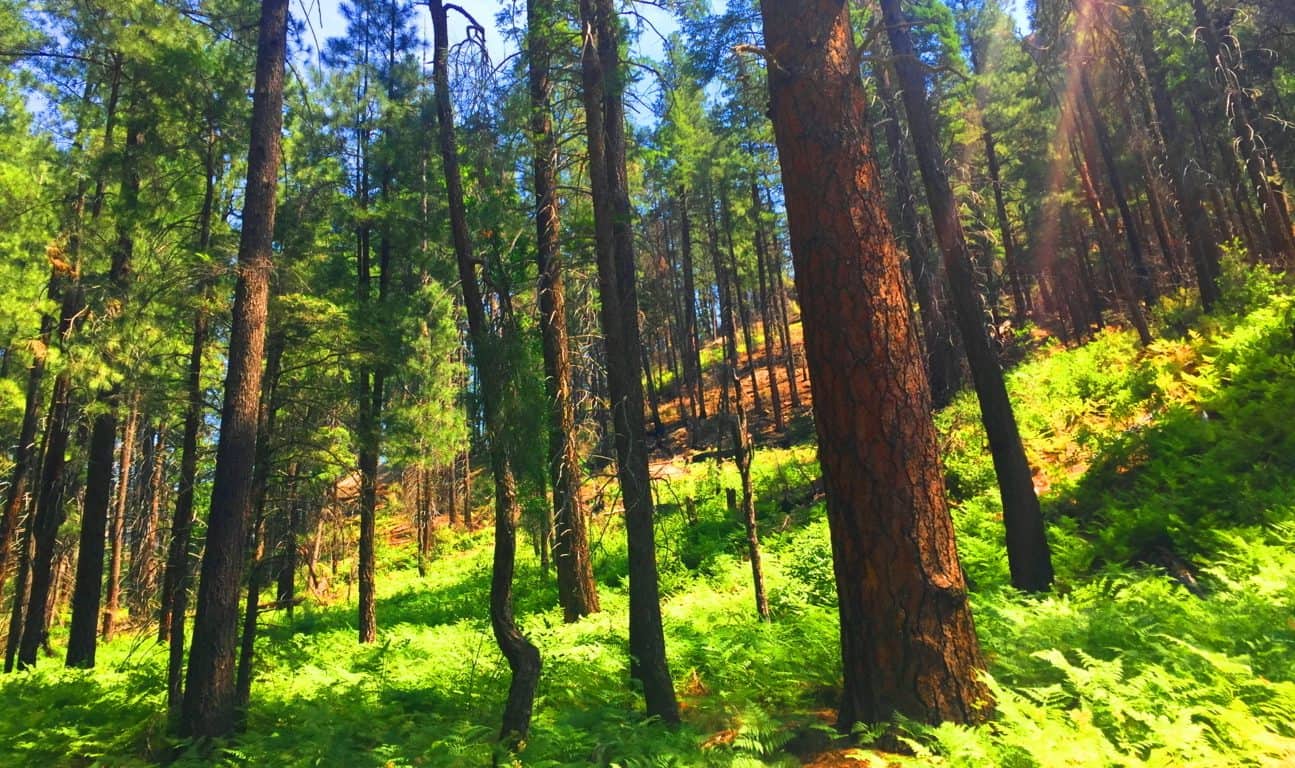
Location: Flagstaff, Arizona.
Elevation: 7000 ft
Note: Coconino National Forest raises some amazing questions and answers about what has really taken place in the beautiful forests of the world. Before wandering into any part of the massive Coconino’, it seems appropriate to have a discussion about the very real enchanted statements that exist in sacred zones. Coconino is certainly one of those sacred zones. Therefore, this article begins with a “Forward” in order to offer logical evidence, rather than tired theories from post-modern science, theories which are quickly being understood as totally ridiculous. Here at Stonestrider is some of the most vanguard and comprehensive work on what is actually revealed by these megalithic stone works, and you will learn something incredible from it. There is an anthropological side of hiking in ancient places, and every so often it is important to review connections, patterns, and evidence. By looking at this material, please understand that you are stepping into something truly magical. I thank everyone who takes the time to consider the evidence in the beautiful places of the world by reading an article like this, and we will wander into Coconino after explaining a few wonderful things about what is taking place here.
Forward: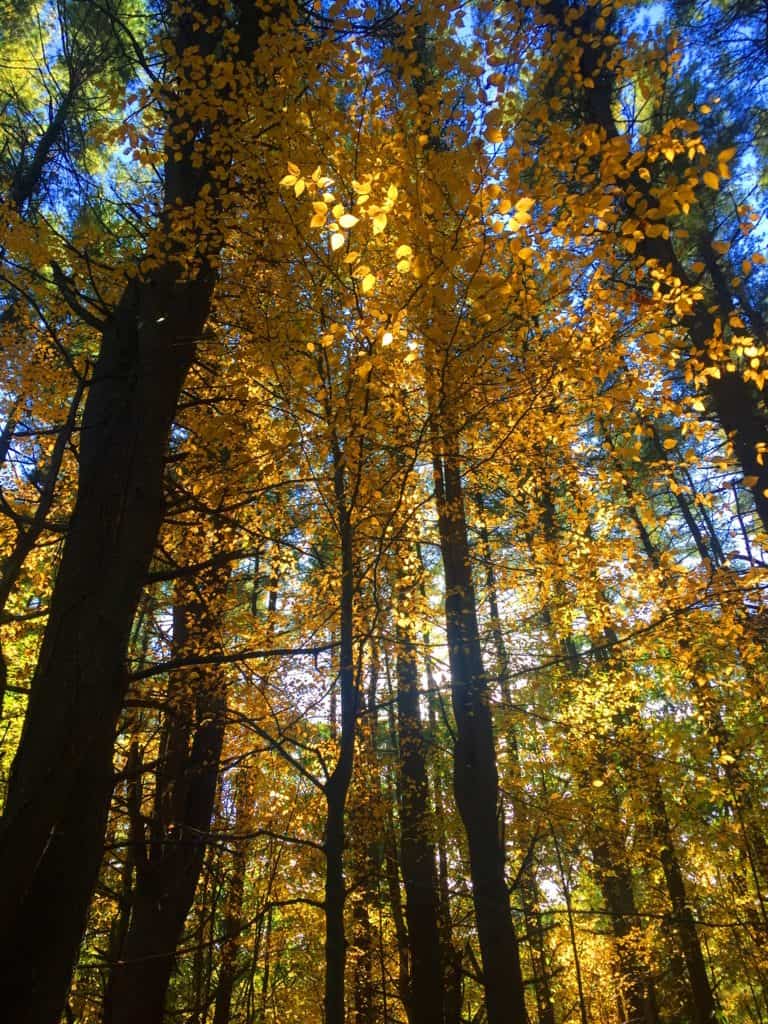 After drifting into roughly 30 forests internationally, and sponsoring this website with many truly challenging expeditions over the course of the last five years, I’m gonna take the chance of going full-on anecdotal for the first time, due to the relevance to The Coconino National Forest featured at the moment, which is one of the largest and most beautiful Pine forests in the entire World (and obviously the continental U.S) Allow me to step back for a moment to set a scene about what Forests mean to me. As a teenager I read, and re–read the works of J.R.R Tolkien, which many students utilized to break the boredom of raw academic classes, ever since the massive novel was first published in the 1950’s. Intrinsic to my photo’s, if you look with a certain eye, are Tolkien’s descriptions; images of mountains, river-glades, and forests which certainly engage all of our imaginations to this day! I realized, while going-over the content for this particular article, that in my mind, before I wander into any forest while out on the trail, that I am always comparing it to one forest in particular from Tolkien’s fictional masterpiece, that forest being Lothlorien. In this regard, I have searched for many years for forests that most closely resembled an enchanted experience, where the deeper you walked in, the more magical and dimensional the experience became. And amazingly enough, from this inspiration I discovered the real-time magic of forests internationally. These are profound discoveries that should be shared, which is the focus of this article.
After drifting into roughly 30 forests internationally, and sponsoring this website with many truly challenging expeditions over the course of the last five years, I’m gonna take the chance of going full-on anecdotal for the first time, due to the relevance to The Coconino National Forest featured at the moment, which is one of the largest and most beautiful Pine forests in the entire World (and obviously the continental U.S) Allow me to step back for a moment to set a scene about what Forests mean to me. As a teenager I read, and re–read the works of J.R.R Tolkien, which many students utilized to break the boredom of raw academic classes, ever since the massive novel was first published in the 1950’s. Intrinsic to my photo’s, if you look with a certain eye, are Tolkien’s descriptions; images of mountains, river-glades, and forests which certainly engage all of our imaginations to this day! I realized, while going-over the content for this particular article, that in my mind, before I wander into any forest while out on the trail, that I am always comparing it to one forest in particular from Tolkien’s fictional masterpiece, that forest being Lothlorien. In this regard, I have searched for many years for forests that most closely resembled an enchanted experience, where the deeper you walked in, the more magical and dimensional the experience became. And amazingly enough, from this inspiration I discovered the real-time magic of forests internationally. These are profound discoveries that should be shared, which is the focus of this article.
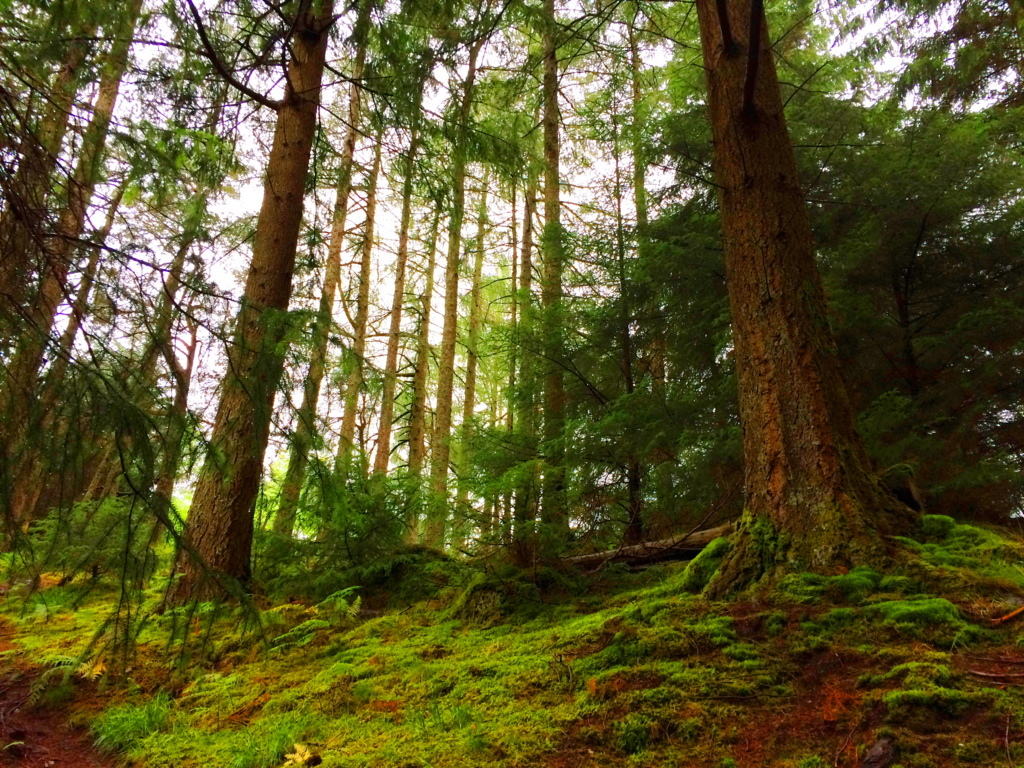 Forests often have particular emotional effects on people. Tolkien, in the Lord of The Rings, also creates a polarity about forests. His characters journey through the beautiful, mystical, spacious, ageless, enchanted Forest of Lothlorien; and then later into the dark, rustic, knarly, timeless Forest of Fanghorn. Some are light, and some are dark. And darker still, is Mirkwood Forest in The Hobbit, the epic prequel to L.O.T.R. (There are other forests as well, like the heart-warming Buckland Forest in the opening of LOTR,(#TolkienNerd), plus what you find in Grimm’s Fairy Tales, or Science Fiction stories of today)
Forests often have particular emotional effects on people. Tolkien, in the Lord of The Rings, also creates a polarity about forests. His characters journey through the beautiful, mystical, spacious, ageless, enchanted Forest of Lothlorien; and then later into the dark, rustic, knarly, timeless Forest of Fanghorn. Some are light, and some are dark. And darker still, is Mirkwood Forest in The Hobbit, the epic prequel to L.O.T.R. (There are other forests as well, like the heart-warming Buckland Forest in the opening of LOTR,(#TolkienNerd), plus what you find in Grimm’s Fairy Tales, or Science Fiction stories of today)
The main point of all this ‘fictional forest referencing’ is to understand that forests have, and promote, specific styles and characteristics all their own, just like people. Some are bright and carefree, with pleasant pathways, and golden Autumn leaves, as in New England (Image/Upper-Left); while Other forests, like Ballachulish in Glen Coe Scotland, are dark and looming, with strong and rustic ancient knolls. Walking through Scottish forest is truly intimidating, with a fear of getting lost in the fog and rain; yet the glens are gorgeous! (Image/Upper-Right). Take a look at another Glen in the Snowdon Forests of Wales, which is as pleasant-a-vale you will ever walk through in your life. This particular glade, which almost looks fictional in real-time, are woods made of an extended family of trees, spacious and airy, with an obvious brightness that nearly forces you to squint just to decipher the full scene. (Image/Lower-Left).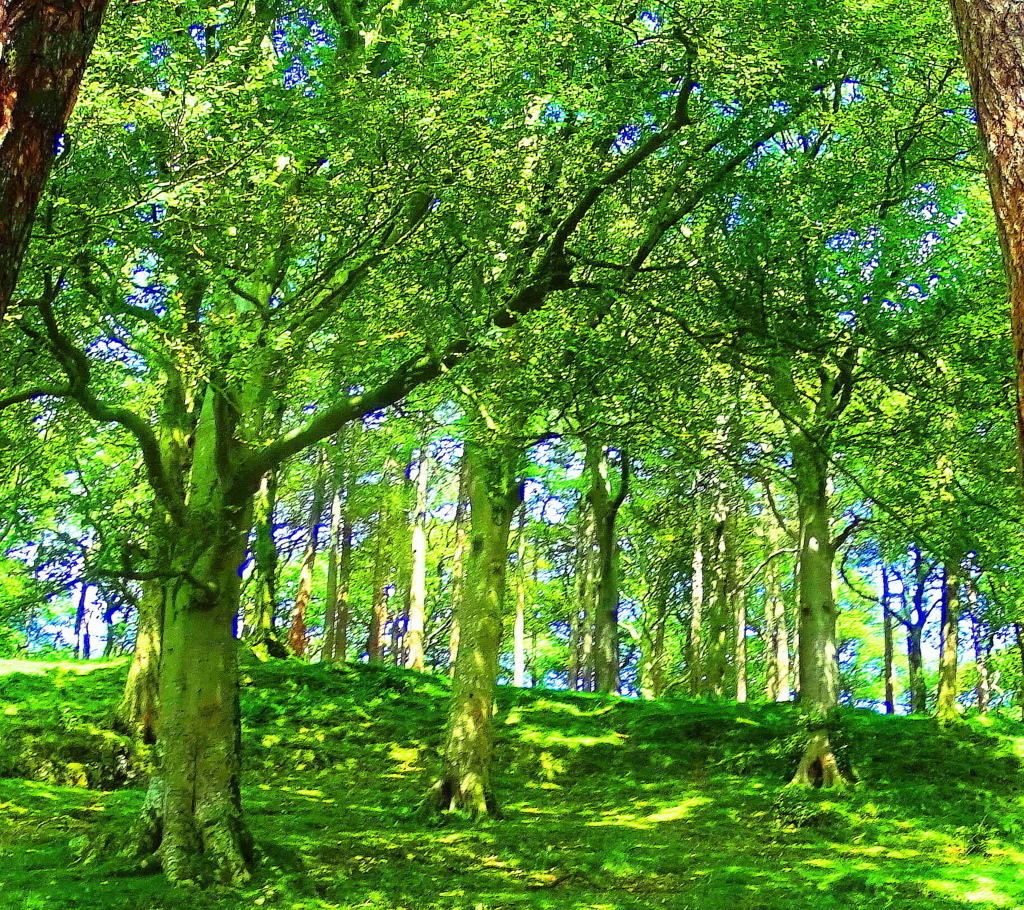 There is a small standing stone at the top of the knoll in this image, which can’t be seen from this spot.
There is a small standing stone at the top of the knoll in this image, which can’t be seen from this spot.
And along those lines, how could I exclude a forest which is, in my opinion, one of the most enchanting paths that has ever been, which is the smaller, but incredibly beautiful, Kinnitty Forest, in the absolute heart of Ireland. This is a rare Celtic Wood, that has been vanishing steadily since the Colonial Period. Irish forests are particularly rare due the British need for resources across the Celtic Sea just 100 miles away. Kinnittty is a rare gem.(Image/Lower-Right)
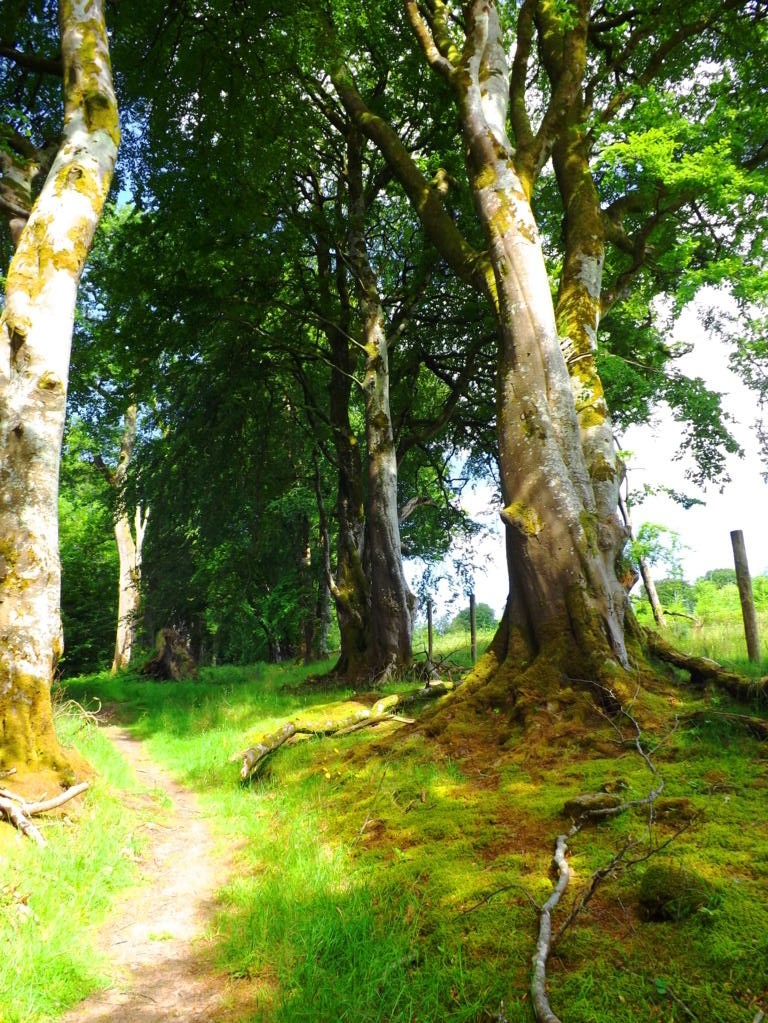
And before finally moving into the deeper meaning of forests, I could not complete this small tour without having a quick glance at the most dense and intimidating forest I’ve ever seen, which is the brilliant Rawah Forest of Medicine Bow National Park in Colorado USA. These are shimmering glades that sway and sift through each other like green-ghosts. In almost all the forests I’ve been I have disappeared into dells that looked to be harboring some kind of clearing or stone-altar; but in Colorado I dared not wander in any away from the old rocky paths. As I have described in other articles, it would be like wondering into the depths of the ocean at night, and like the ocean, it is an overwhelmingly profound statement about the abundance of Nature’s forces, ever blooming in our complicated world. (Image/Below)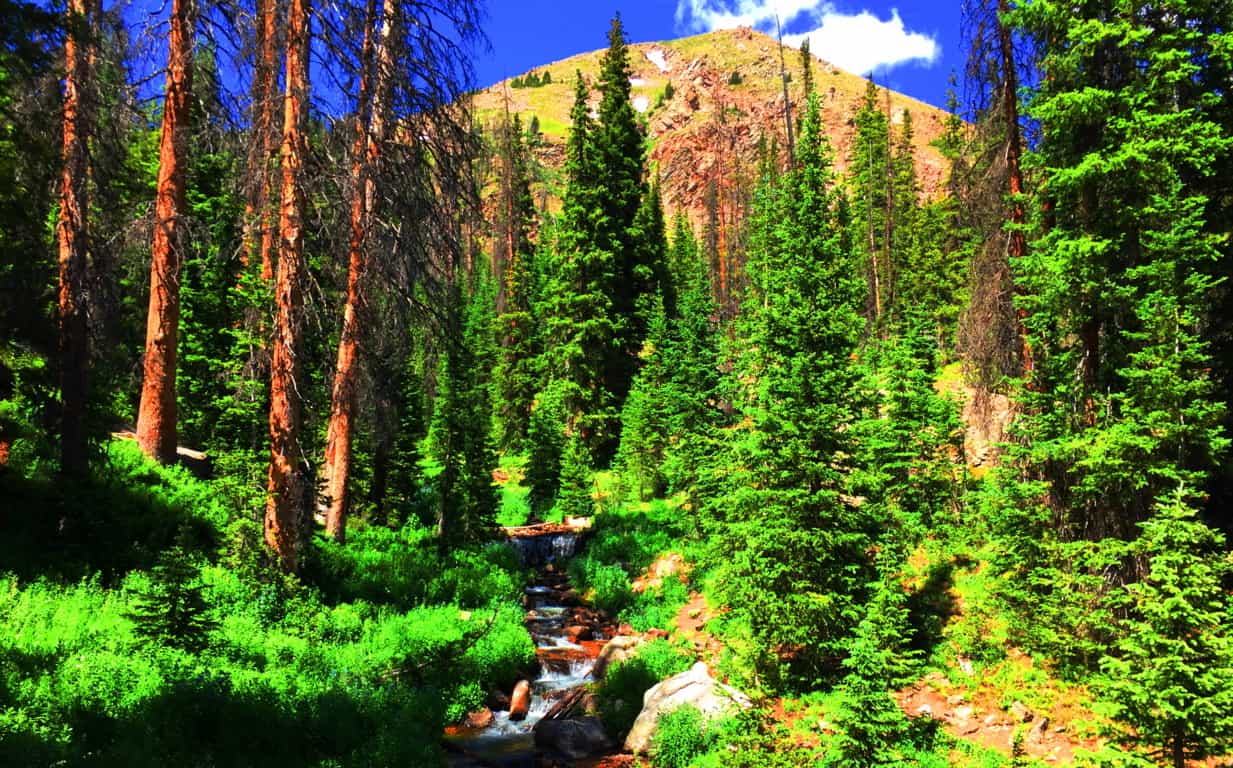 Forest Mysteries: I hope with this brief set of examples that it’s a little more clear how forests have enchanting and unique personalities. This “enchanting” vibe, if you look even closer, doesn’t come from the glades alone; there is something even more strange and mysterious beneath the tree tops. There are megaliths and impossibly crafted stones. This mysterious trend is an international phenomenon, where specific geometric patterns of stones, along with incredible feats of megalithic engineering, emerge deep within the woods, beneath sacred mountainsides, from Glen Coe, Scotland, all the way to Arizona, USA. After establishing proper anthropological and mathematical similarities in stones from forests nearly 3000 latitudinal miles away from each other (that’s North to South) the obvious question emerges: “How can this “glacial” arguement continue to hold up?
Forest Mysteries: I hope with this brief set of examples that it’s a little more clear how forests have enchanting and unique personalities. This “enchanting” vibe, if you look even closer, doesn’t come from the glades alone; there is something even more strange and mysterious beneath the tree tops. There are megaliths and impossibly crafted stones. This mysterious trend is an international phenomenon, where specific geometric patterns of stones, along with incredible feats of megalithic engineering, emerge deep within the woods, beneath sacred mountainsides, from Glen Coe, Scotland, all the way to Arizona, USA. After establishing proper anthropological and mathematical similarities in stones from forests nearly 3000 latitudinal miles away from each other (that’s North to South) the obvious question emerges: “How can this “glacial” arguement continue to hold up?  Free-sitting boulders at advantageous vantage points in the forests of New England (Image/Below/Right) Ireland (Image/Left) England, Scotland, and Wales are technically similar to free-sitting boulders in Wyoming, Colorado, and Arizona.
Free-sitting boulders at advantageous vantage points in the forests of New England (Image/Below/Right) Ireland (Image/Left) England, Scotland, and Wales are technically similar to free-sitting boulders in Wyoming, Colorado, and Arizona.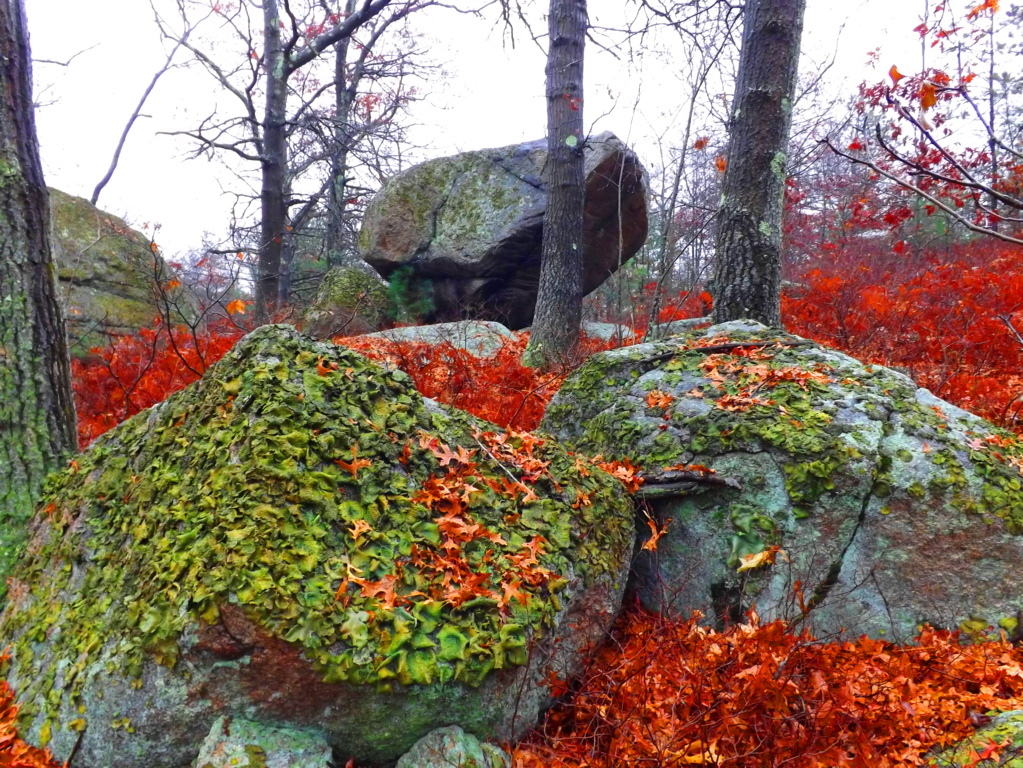 How the hell is this possible? Did the most recent Ice-Age glacier of roughly 40,000 years ago reach all the way down to Arizona’s volcanic mountain deserts? It just doesn’t make sense. Technically, the continent-sized ice mass that covered what would be the American West was called the Cordilleran, which looks to have stopped on the border of what would eventually be Canada. So, simply put, how are scientists claiming that free-sitting boulders like this one in the Coconino Forest in central Flagstaff was moved by the same glacier as the boulders in New England and Ireland? (Image/Lower/Left)
How the hell is this possible? Did the most recent Ice-Age glacier of roughly 40,000 years ago reach all the way down to Arizona’s volcanic mountain deserts? It just doesn’t make sense. Technically, the continent-sized ice mass that covered what would be the American West was called the Cordilleran, which looks to have stopped on the border of what would eventually be Canada. So, simply put, how are scientists claiming that free-sitting boulders like this one in the Coconino Forest in central Flagstaff was moved by the same glacier as the boulders in New England and Ireland? (Image/Lower/Left)
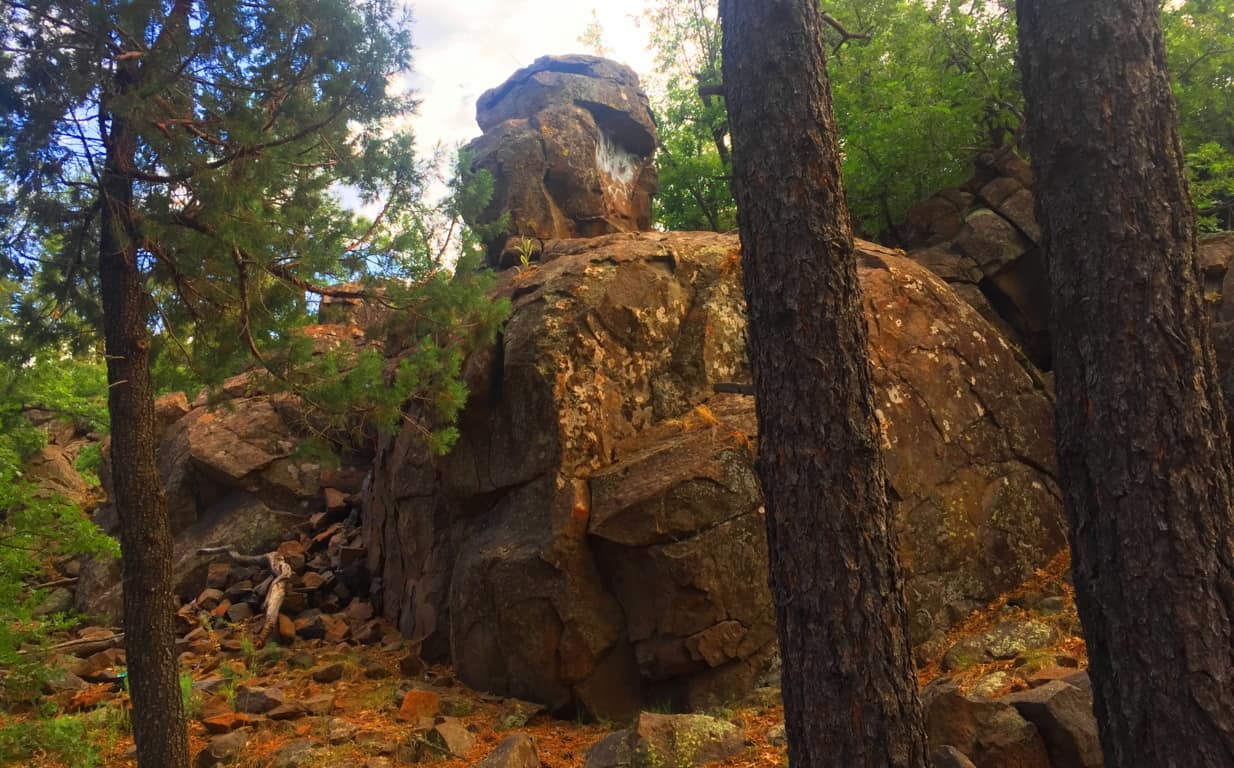 I examined this Arizona boulder, and more importantly, the slope of the ledge it sits on, and the angle is very telling of how unlikely it is that this boulder remained on this ledge from an at-random geologic process. There is 15 degree slope on the ledge-top, as you can see. To counter that, on the boulder’s base, is a cut of about 15 degrees, fitting the boulder to the ledge perfectly. This is a fixture; an intentional fit, in my opinion. Additionally, there are markings all over this boulder, which is a type of “ledge-boulder” found in sacred zones all over the country. The odds that all of these boulders are placed at random at the very edge of vantage-giving ledges is, to put it blatantly: gastronomical multiplied by gastronomical; impossible.
I examined this Arizona boulder, and more importantly, the slope of the ledge it sits on, and the angle is very telling of how unlikely it is that this boulder remained on this ledge from an at-random geologic process. There is 15 degree slope on the ledge-top, as you can see. To counter that, on the boulder’s base, is a cut of about 15 degrees, fitting the boulder to the ledge perfectly. This is a fixture; an intentional fit, in my opinion. Additionally, there are markings all over this boulder, which is a type of “ledge-boulder” found in sacred zones all over the country. The odds that all of these boulders are placed at random at the very edge of vantage-giving ledges is, to put it blatantly: gastronomical multiplied by gastronomical; impossible.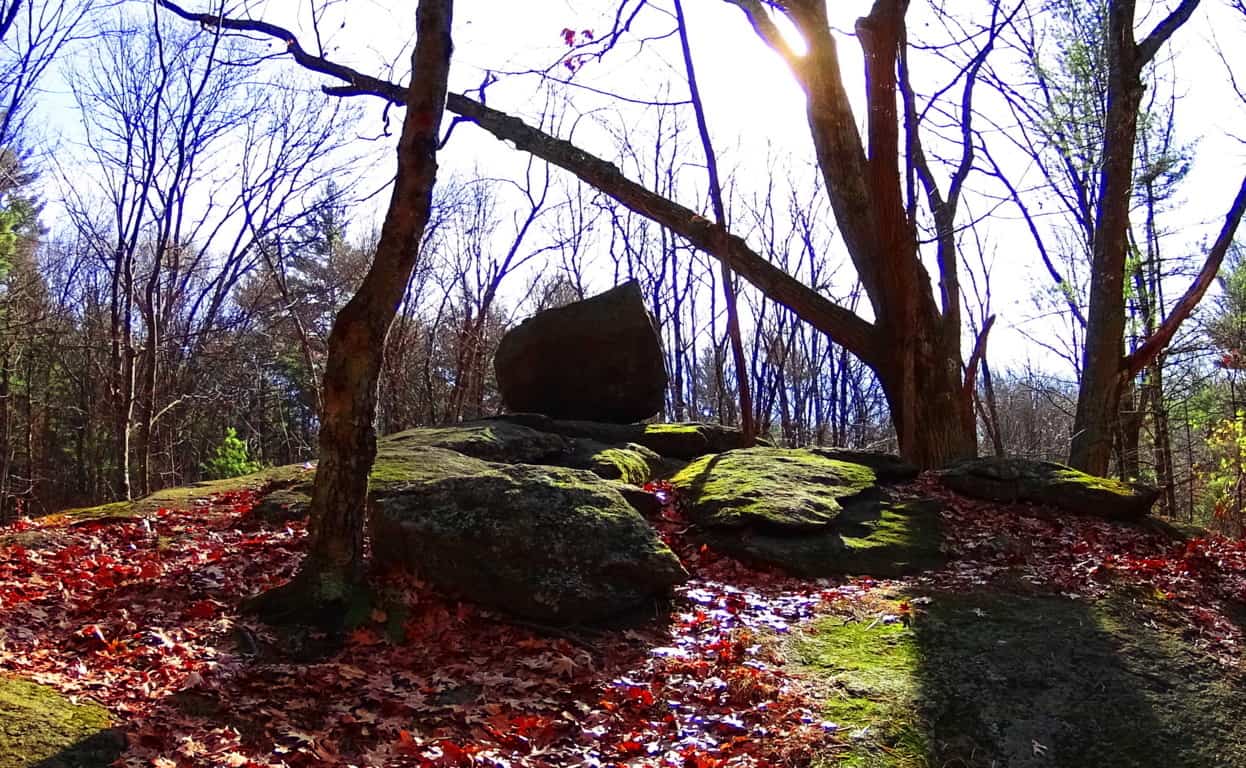
Take a look at yet another free-sitting boulder on a rounded ledge which is ‘vantage-giving’. This boulder is 2500 miles away, in New England. See how rounded this ledge is? For this boulder to remain fixed on top of this rounded precipice it would have to sit in the absolute gravitational center, which it does. Again this an example where if you use logic, and not simply dismiss the statement with brazen theories about ancient ice-sheets, the truth will come out. Someone, or something put this boulder here in order to say: “This is my zone; see how strong I am; beware!”
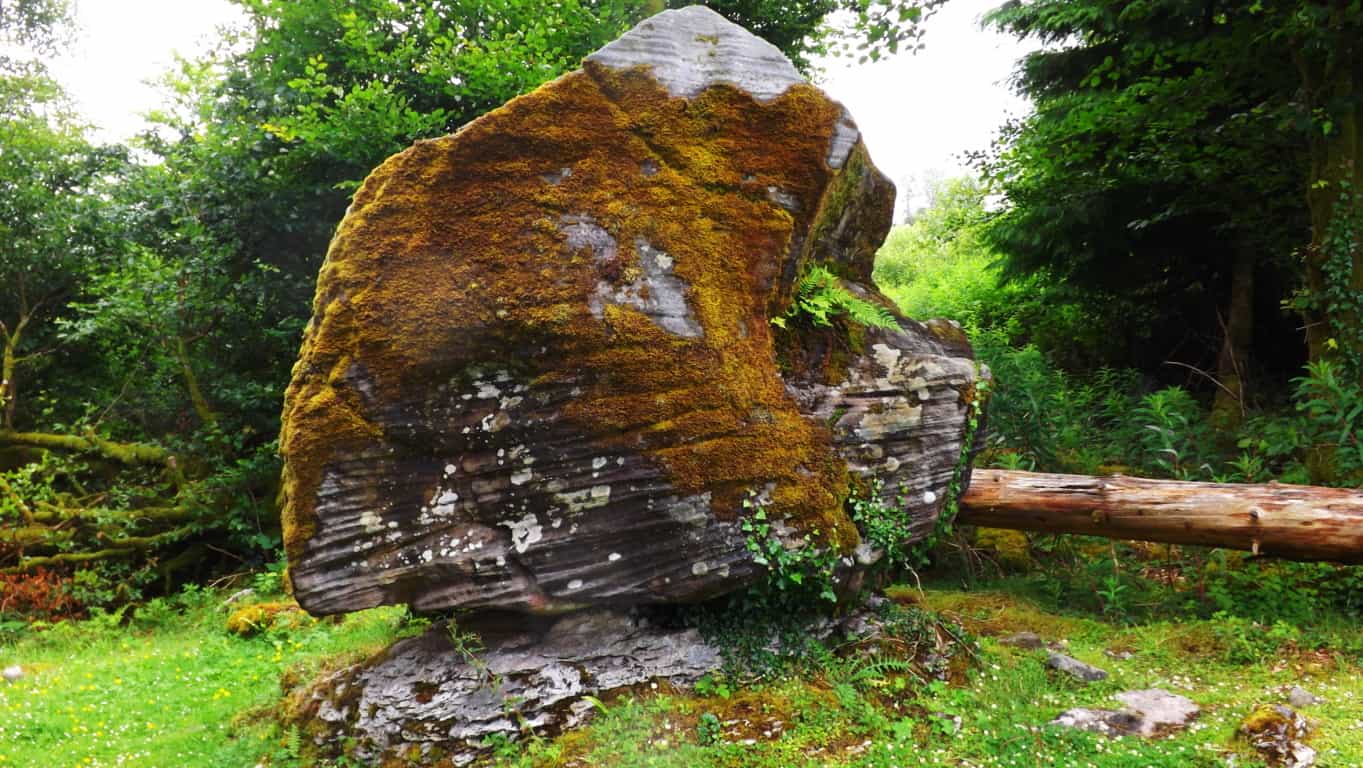 If this “territorial fixture” still doesn’t seem realistic to you, take a look at this amazing statement at Cavan Burren National Park in Ireland. It should be understood by the reader that Cavan Burren is filled with sacred megaliths; altars with standing stones, small temples, and Neolithic engineering. Someone claimed this space for themselves in antiquity, and in this space what do we find? A free-sitting boulder perfectly placed on a tiny platform of bedrock. Modern “science” is telling us to believe a massive glacier rolled this single boulder hundreds, or even thousands of miles, only to land it perfectly square and set on this minuscule 4 by 3 foot space of embedded rock? No. Impossible. Absurd. Illogical. And to me, insulting. Again, this is clearly an example of a boulder which was placed by an individual(s) in ancient times, as a statement to others that this zone is occupied, and by someone with incredible strength and know-how. Furthermore, here are some of the Neoliths found within just 25 yards of this boulder:
If this “territorial fixture” still doesn’t seem realistic to you, take a look at this amazing statement at Cavan Burren National Park in Ireland. It should be understood by the reader that Cavan Burren is filled with sacred megaliths; altars with standing stones, small temples, and Neolithic engineering. Someone claimed this space for themselves in antiquity, and in this space what do we find? A free-sitting boulder perfectly placed on a tiny platform of bedrock. Modern “science” is telling us to believe a massive glacier rolled this single boulder hundreds, or even thousands of miles, only to land it perfectly square and set on this minuscule 4 by 3 foot space of embedded rock? No. Impossible. Absurd. Illogical. And to me, insulting. Again, this is clearly an example of a boulder which was placed by an individual(s) in ancient times, as a statement to others that this zone is occupied, and by someone with incredible strength and know-how. Furthermore, here are some of the Neoliths found within just 25 yards of this boulder:
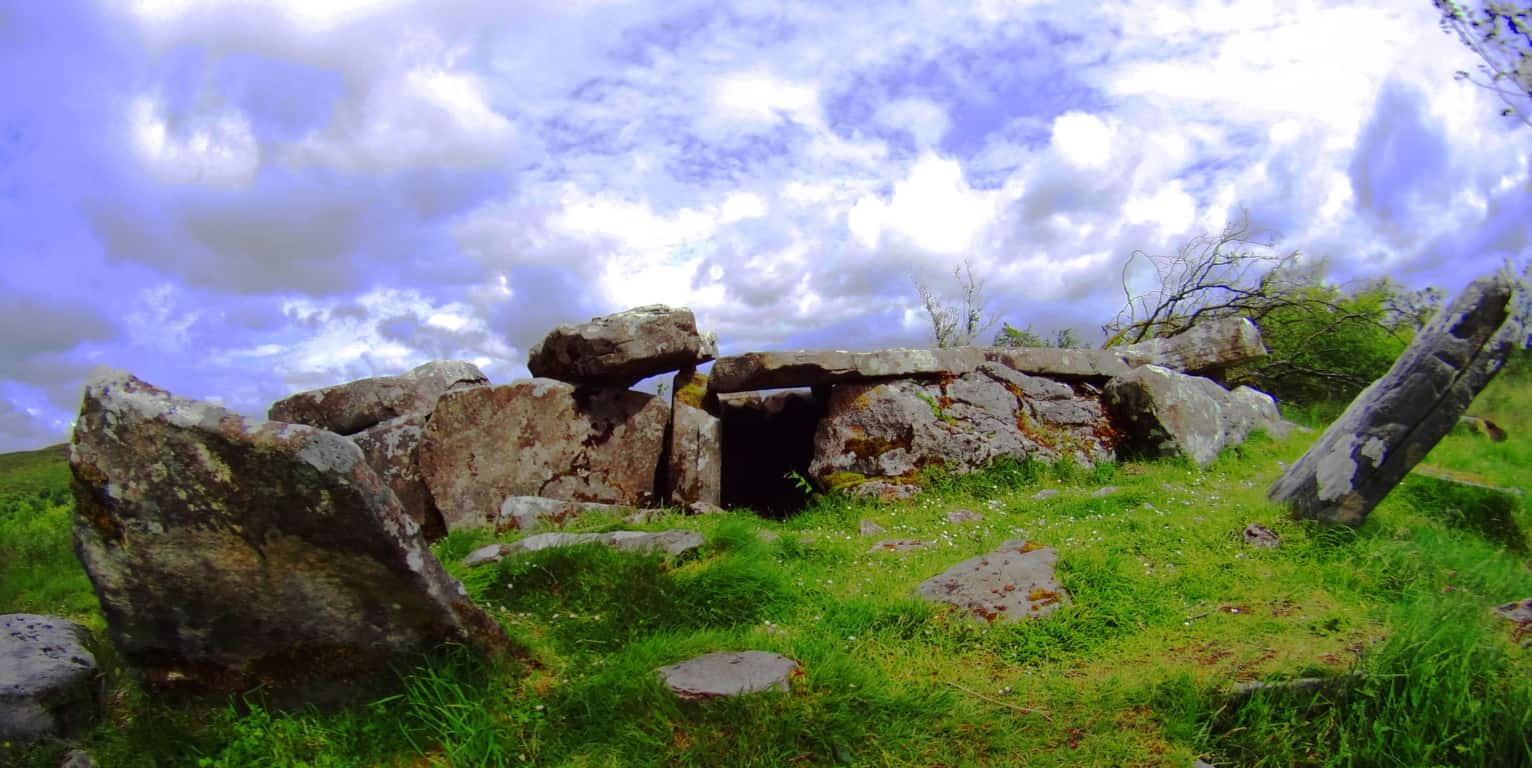 (Image/Left) and (Image/Below/Right). How can we go on believing the academic narrative of the post-modernists? They are blatantly lying to us in their white-papers, mini-museums, and gift shops. Why? What do they not want us to conclude? Well, regardless, perhaps these academics didn’t expect someone with a Degree in Western Literature, and some perspective, to make the effort to actually study these places in detail. Perhaps they are RELYING on the fact that people don’t make the effort to stride into these sacred zones from one continent to the next. And these free-standing statements can be found in forests all over the world. Here’s a look at some of the very strange and distinct boulders that remain in Cavan Burren Forest, just 100 yards from the Wedge Tombs. Celtic glades in Ireland are rare, and these boulders are strewn into the landscape like an above ground cable system. Covered in glowing green moss, they just looked to have some positional secret yet to be understood…
(Image/Left) and (Image/Below/Right). How can we go on believing the academic narrative of the post-modernists? They are blatantly lying to us in their white-papers, mini-museums, and gift shops. Why? What do they not want us to conclude? Well, regardless, perhaps these academics didn’t expect someone with a Degree in Western Literature, and some perspective, to make the effort to actually study these places in detail. Perhaps they are RELYING on the fact that people don’t make the effort to stride into these sacred zones from one continent to the next. And these free-standing statements can be found in forests all over the world. Here’s a look at some of the very strange and distinct boulders that remain in Cavan Burren Forest, just 100 yards from the Wedge Tombs. Celtic glades in Ireland are rare, and these boulders are strewn into the landscape like an above ground cable system. Covered in glowing green moss, they just looked to have some positional secret yet to be understood…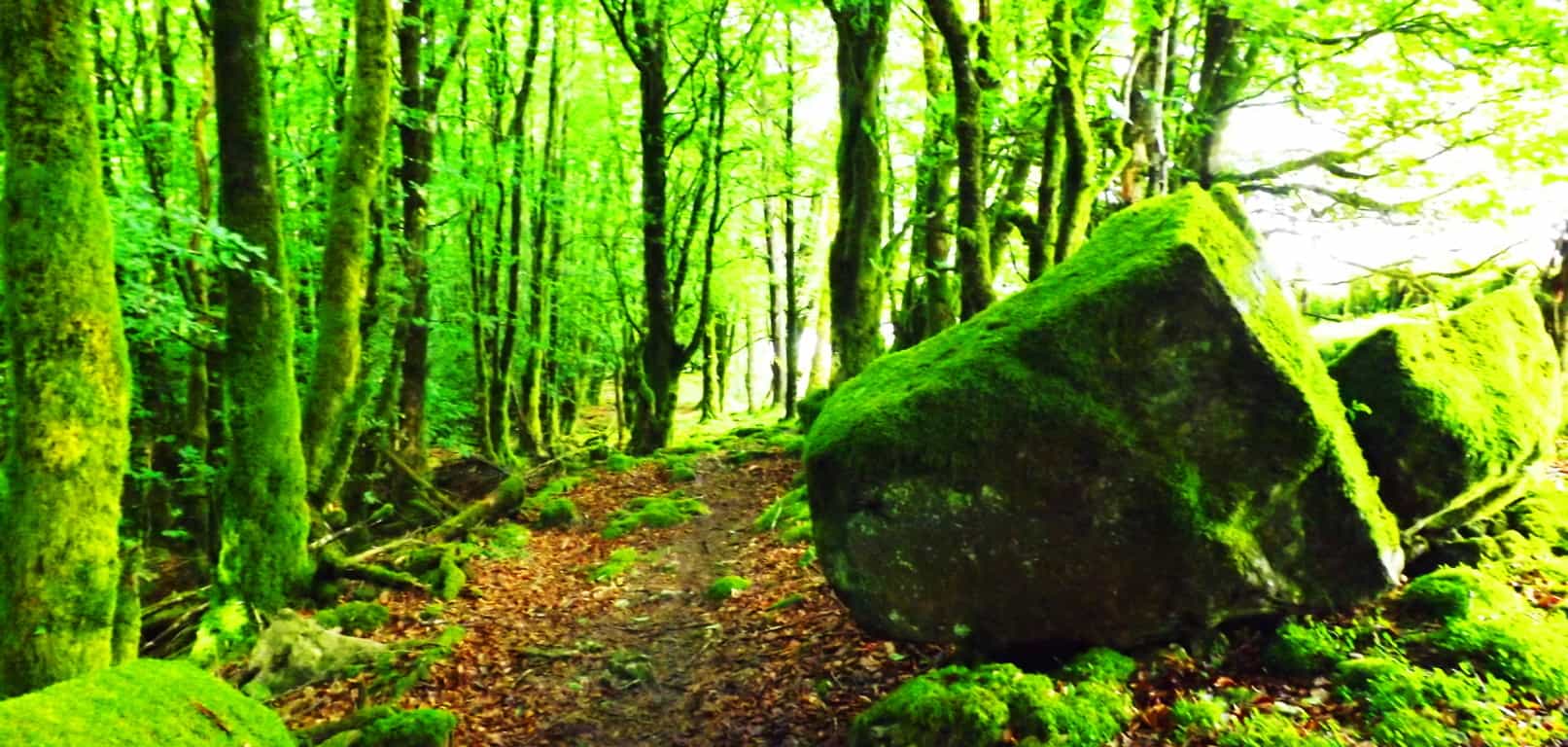
And now take a look at a similarly stoic boulder in the forest of Cococino, 4000 miles away. It has precise indents on its side, also with a strange glow, which is of course rusty orange, rather than mossy green. These boulders seem plotted, or planted, rather than randomly tossed about by ice. They are both squared and monumental, as opposed to disheveled. Another very real possibility is that the stones were there long before the forests grew. Were the stones there before the glacier came along? In some forests you can easily see that the stones were there first, as the trees grow straight over the rock. The point is, there are a great many questions that are not answered by the one size fits all modern answers of “glacial displacement.”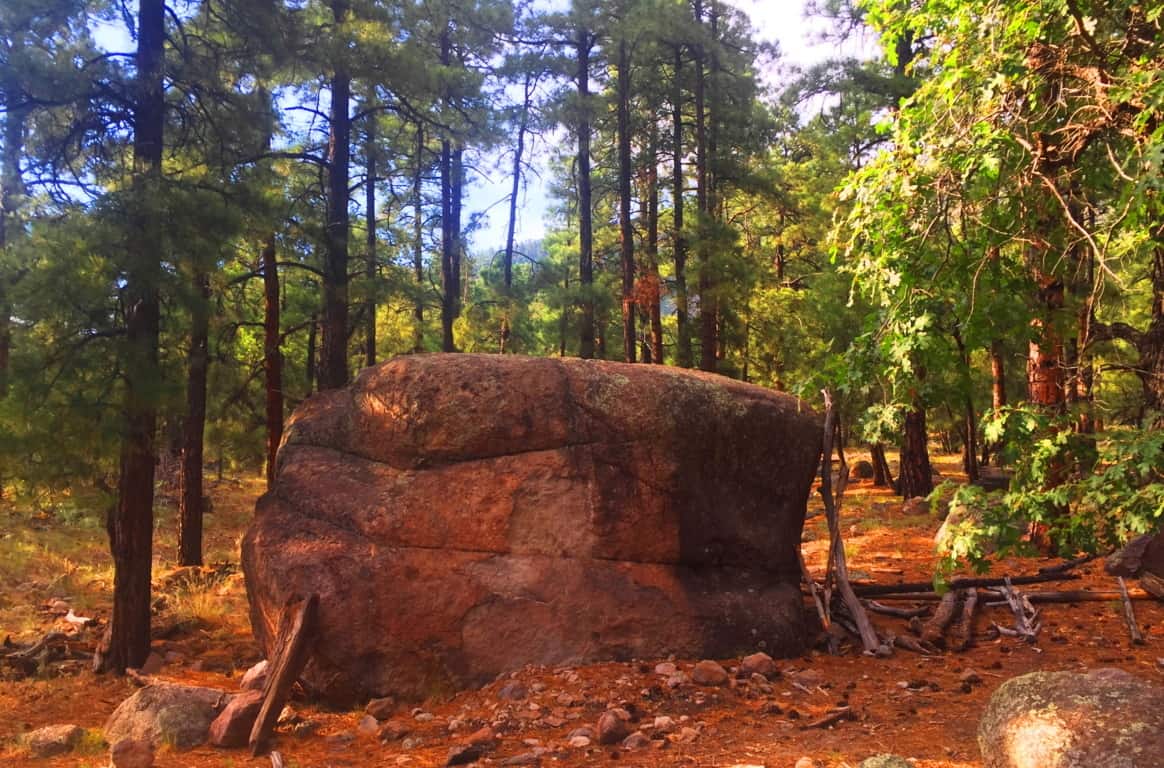 Coconino National Forest: Welcome to a Ponderosa Pine vale that stretches from the northern to southern heart of Arizona. Grand sections of forest emerge all the way from the Grand Canyon down to Sunset Crater Flagstaff, continuing even further down through Oak Creek Canyon, in Sedona. In this environment entire glades of trees are literally on the edge of burning at any given moment. Many trees are already lying prostrate on the ground with limbs seemingly reaching to the heavens, begging to be finally ignited by the Sun. I had just never seen trees like this before.
Coconino National Forest: Welcome to a Ponderosa Pine vale that stretches from the northern to southern heart of Arizona. Grand sections of forest emerge all the way from the Grand Canyon down to Sunset Crater Flagstaff, continuing even further down through Oak Creek Canyon, in Sedona. In this environment entire glades of trees are literally on the edge of burning at any given moment. Many trees are already lying prostrate on the ground with limbs seemingly reaching to the heavens, begging to be finally ignited by the Sun. I had just never seen trees like this before. Even with the challenge of an extremely arid climate, many incredibly delicate and beautiful statements emerge in the dry hedge and shade. These wildflowers just look so resilient against a massive canvas dry-wood in the background.
Even with the challenge of an extremely arid climate, many incredibly delicate and beautiful statements emerge in the dry hedge and shade. These wildflowers just look so resilient against a massive canvas dry-wood in the background.
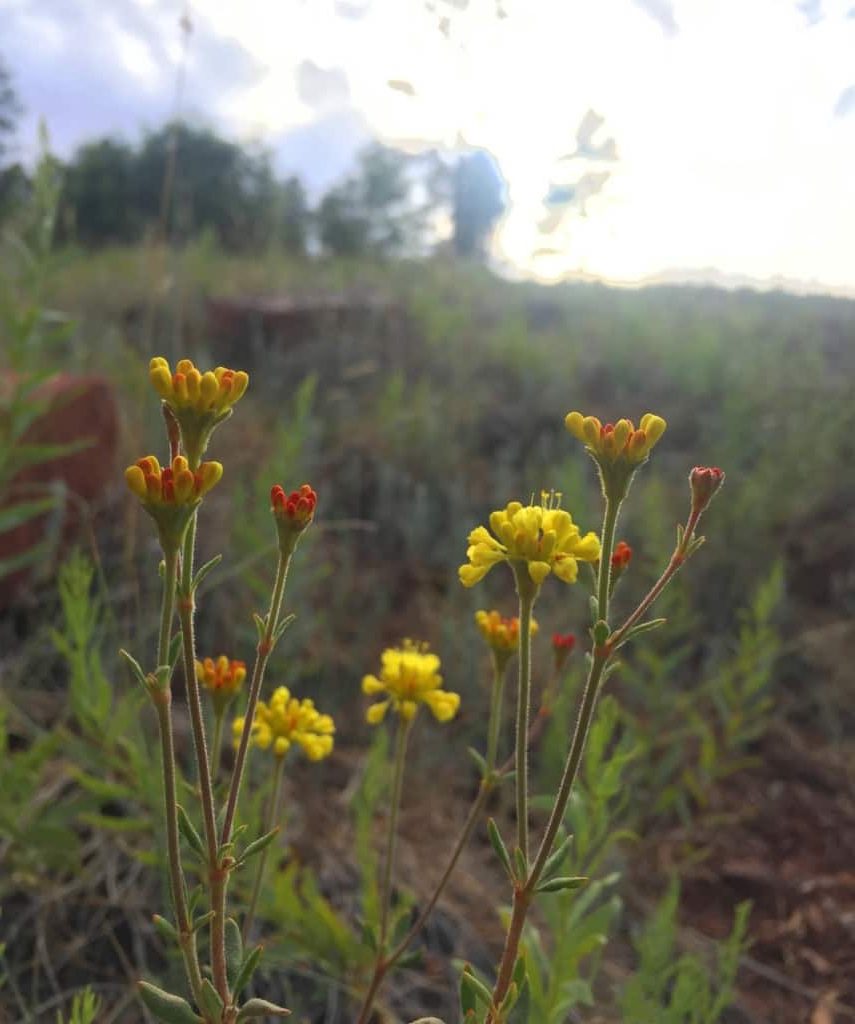
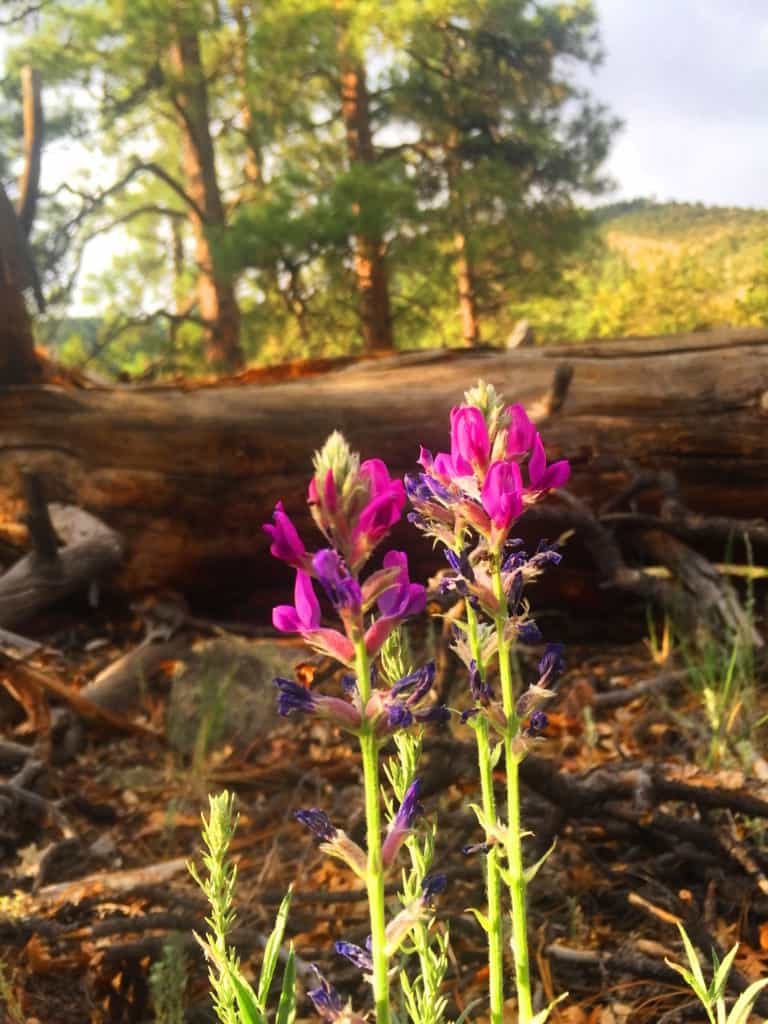
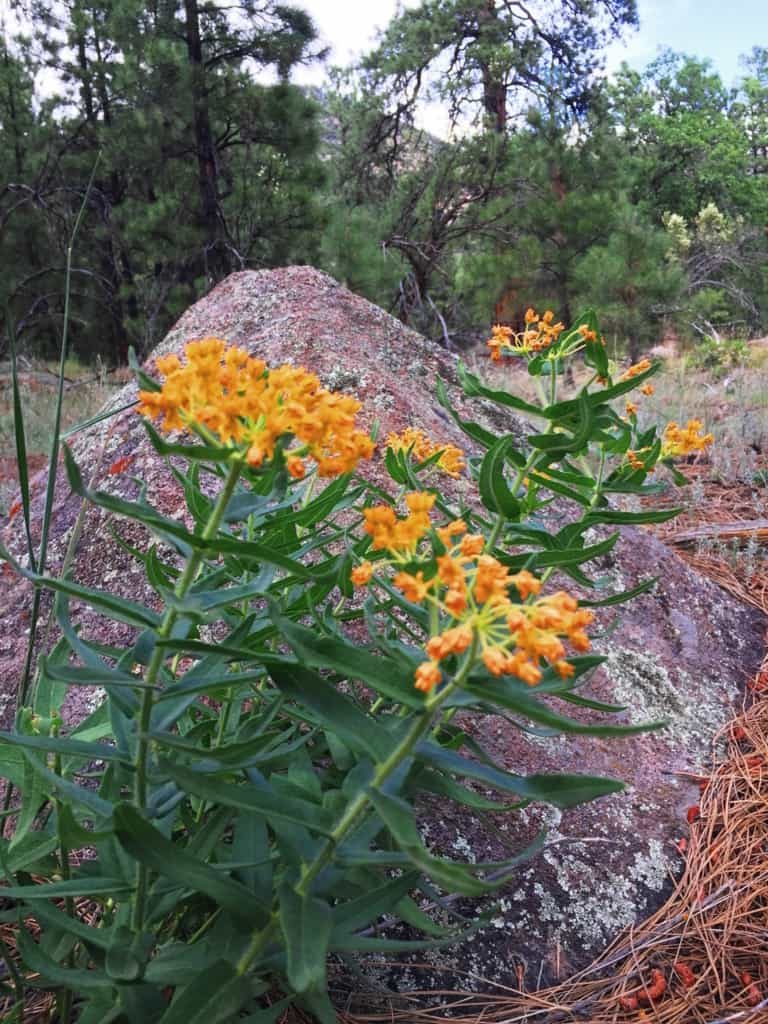 You will have to make a decision about where and when you want to wander into the Coconino’. The northern section of the Forest sits at the edge of the Grand Canyon, near the great Southern Rim. This requires traveling through the beautiful desert plain to arrive at the Canyon. The central section of the Forest is roughly 150 miles south of the Grand Canyon, stretching from Sunset Crater National Park to the The San Francisco Peaks, which are the rugged mountains that engulf the city of Flagstaff. Much of the Forest can be found at the base of Mount Humphries, climbing all the way to the peak, which stands at 12,365 feet above Sea Level, and offering 6000 feet of Prominence. That’s a pretty serious climb, and one which I did not make during this particular excursion. The area is truly a wonderland, with possibilities in every direction, and it is nearly impossible to miss a mountain, canyon, or forest trail, in this part of Arizona. Flagstaff is the place where I chose to enter the Coconino first.
You will have to make a decision about where and when you want to wander into the Coconino’. The northern section of the Forest sits at the edge of the Grand Canyon, near the great Southern Rim. This requires traveling through the beautiful desert plain to arrive at the Canyon. The central section of the Forest is roughly 150 miles south of the Grand Canyon, stretching from Sunset Crater National Park to the The San Francisco Peaks, which are the rugged mountains that engulf the city of Flagstaff. Much of the Forest can be found at the base of Mount Humphries, climbing all the way to the peak, which stands at 12,365 feet above Sea Level, and offering 6000 feet of Prominence. That’s a pretty serious climb, and one which I did not make during this particular excursion. The area is truly a wonderland, with possibilities in every direction, and it is nearly impossible to miss a mountain, canyon, or forest trail, in this part of Arizona. Flagstaff is the place where I chose to enter the Coconino first.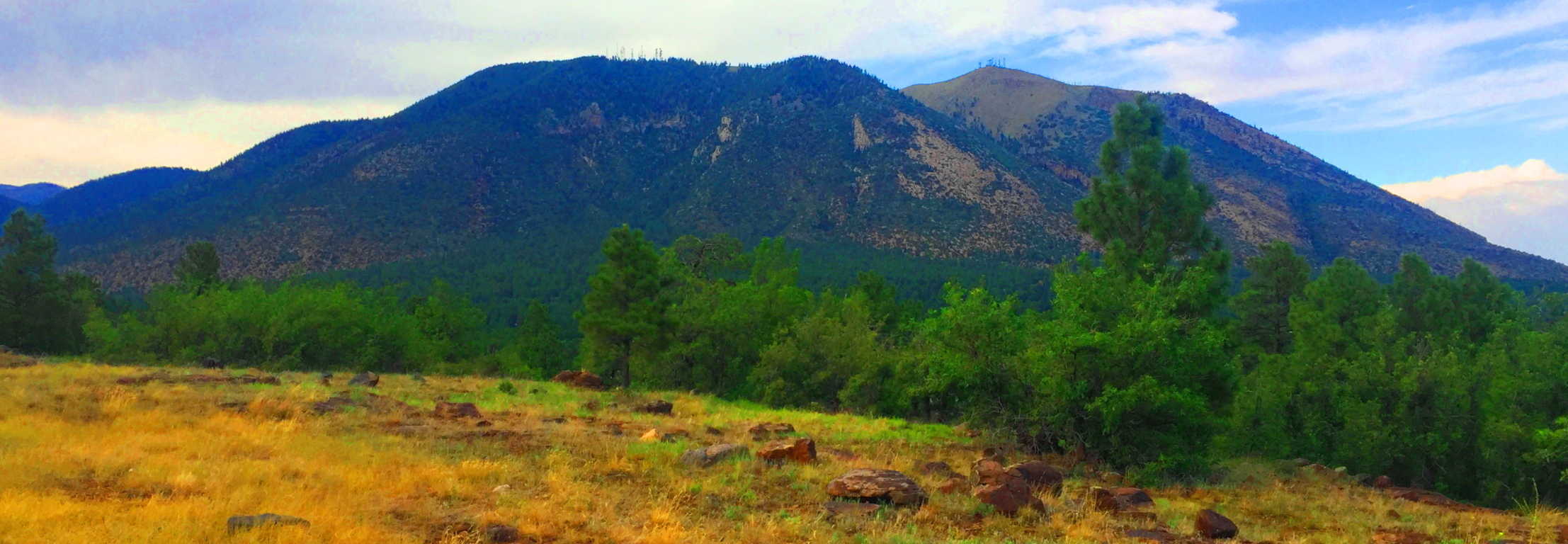 The Coconino Forest at Buffalo Park: There are half a dozen parks and entries for the Forest in Flagstaff. Buffalo Park is a 700 foot elevation hill encompassing about 5 by 15 miles of quiet grassland above, and on the edge of Flagstaff.
The Coconino Forest at Buffalo Park: There are half a dozen parks and entries for the Forest in Flagstaff. Buffalo Park is a 700 foot elevation hill encompassing about 5 by 15 miles of quiet grassland above, and on the edge of Flagstaff.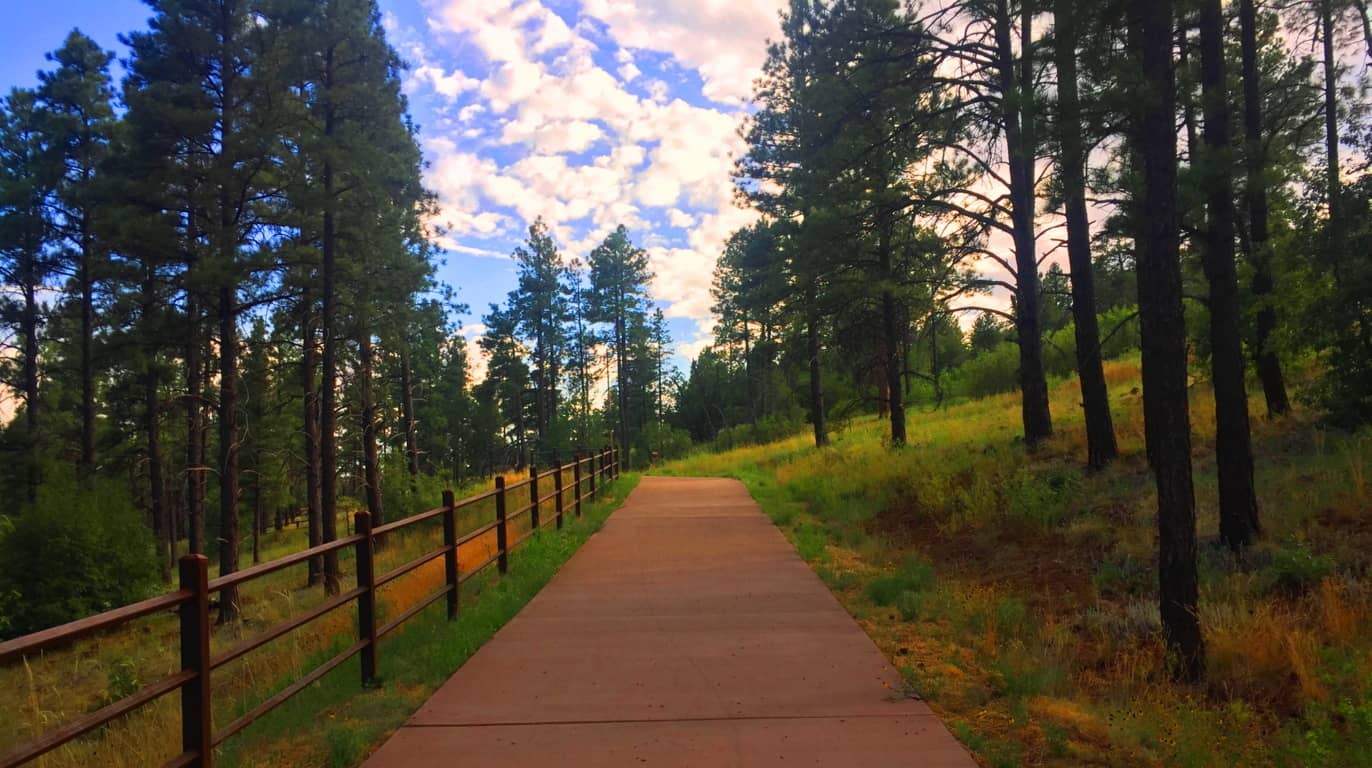 At the top, after sifting through the Forest, the area opens up to a surprisingly vast and peaceful scene. (Image/Below)
At the top, after sifting through the Forest, the area opens up to a surprisingly vast and peaceful scene. (Image/Below)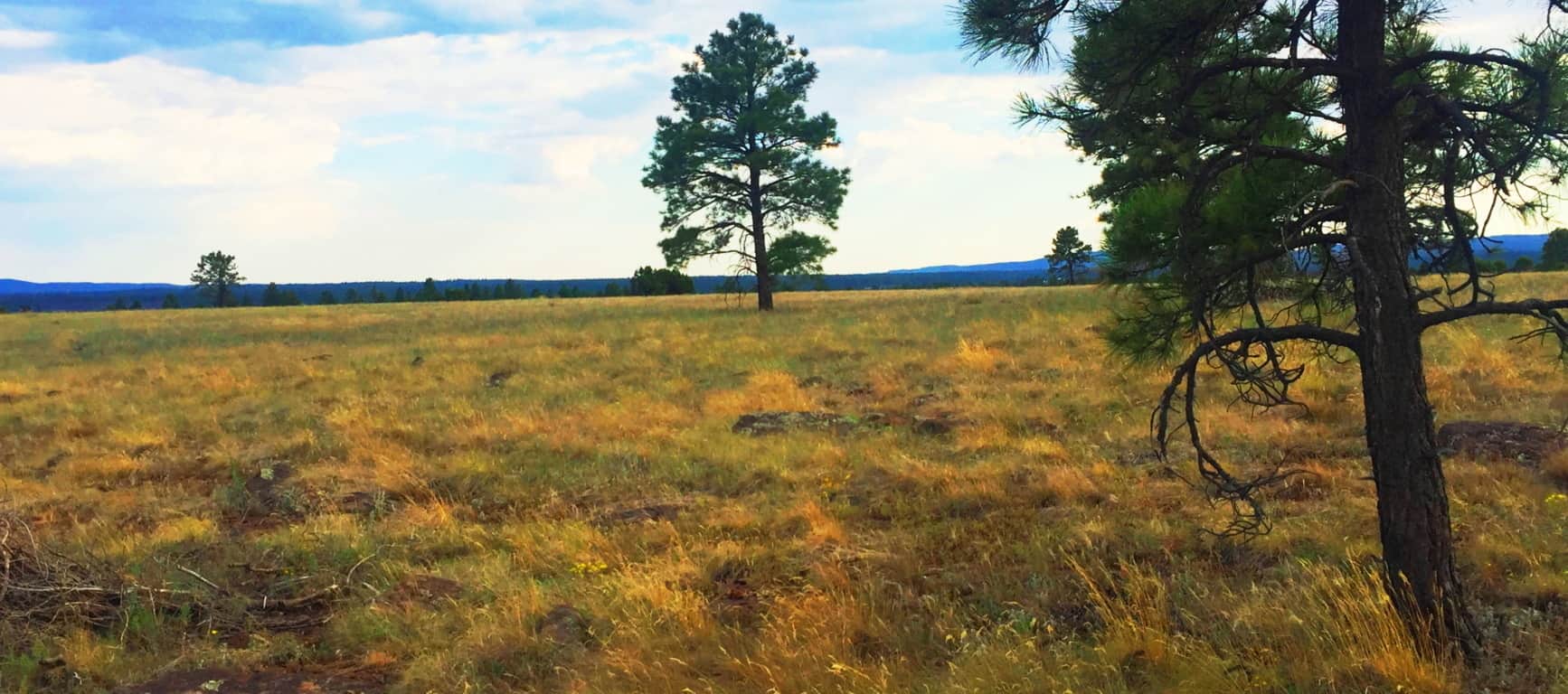 This plateau is like the American West’s rustic version of Ireland’s Hill of Tara (Image/Below/Left) although it was far less lush than the near perfect setting of Tara’. The quiet was very similar though, both hills were places to feel the high winds and absorb the day. It was easy to see that this hill, perhaps 500 years ago, would’ve certainly been a serene place for the Natives, who built stone huts in the deeper forest just a 1000 yards away from here. The size and scale of Coconino and Tara’ is eerily similar.
This plateau is like the American West’s rustic version of Ireland’s Hill of Tara (Image/Below/Left) although it was far less lush than the near perfect setting of Tara’. The quiet was very similar though, both hills were places to feel the high winds and absorb the day. It was easy to see that this hill, perhaps 500 years ago, would’ve certainly been a serene place for the Natives, who built stone huts in the deeper forest just a 1000 yards away from here. The size and scale of Coconino and Tara’ is eerily similar.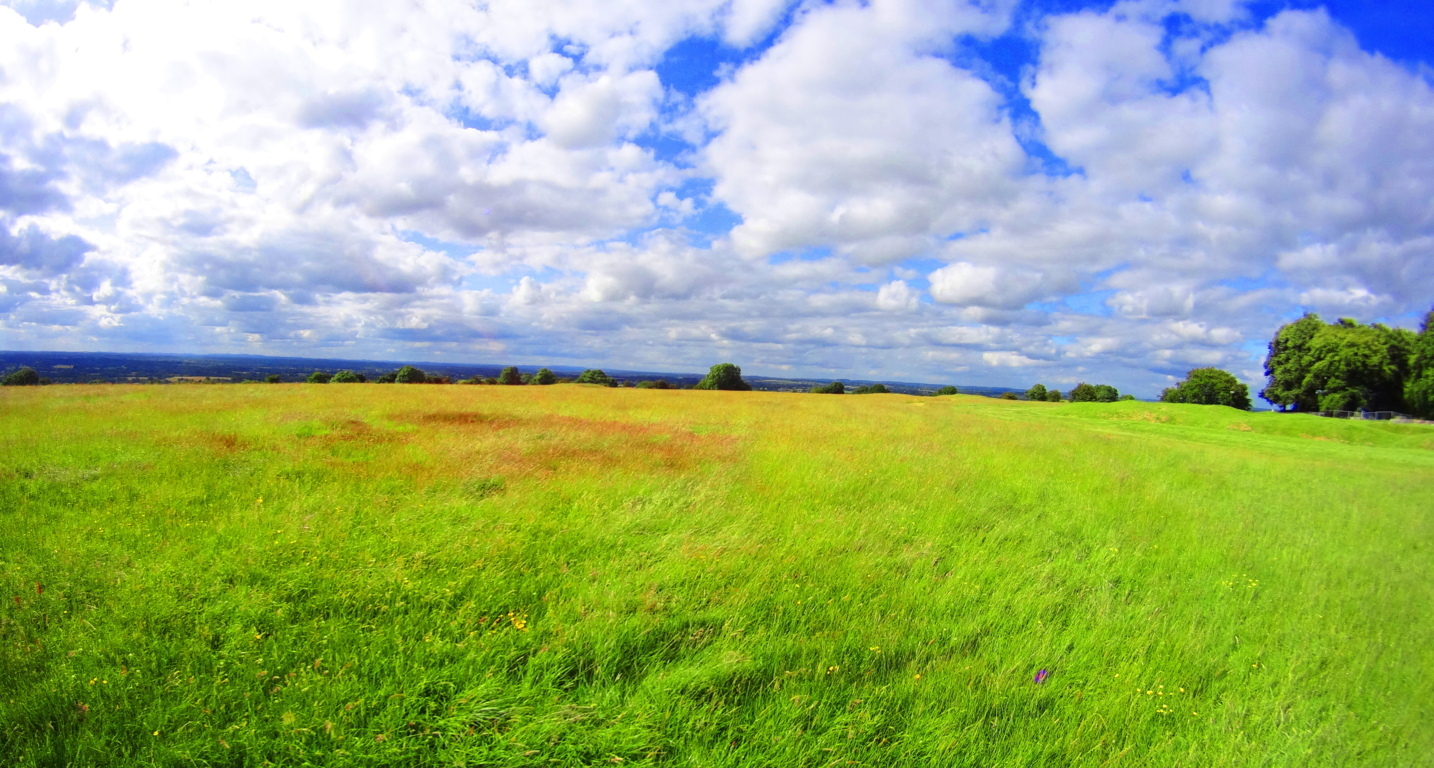 The trees and stone-fixtures surrounding the Hill at Buffalo Park seems as enchanted as the megaliths in, say, the Mourne Range in Ireland, or the Berkshire Range in Massachusetts. As explained at the beginning of the article, certain areas felt more like claimed cliff-spaces from the beginning of Time. Buffalo Park is just a teaser to the more dense forest which is closer to Mount Humphries, a beautiful wilderness looming in the immediate distance.
The trees and stone-fixtures surrounding the Hill at Buffalo Park seems as enchanted as the megaliths in, say, the Mourne Range in Ireland, or the Berkshire Range in Massachusetts. As explained at the beginning of the article, certain areas felt more like claimed cliff-spaces from the beginning of Time. Buffalo Park is just a teaser to the more dense forest which is closer to Mount Humphries, a beautiful wilderness looming in the immediate distance. 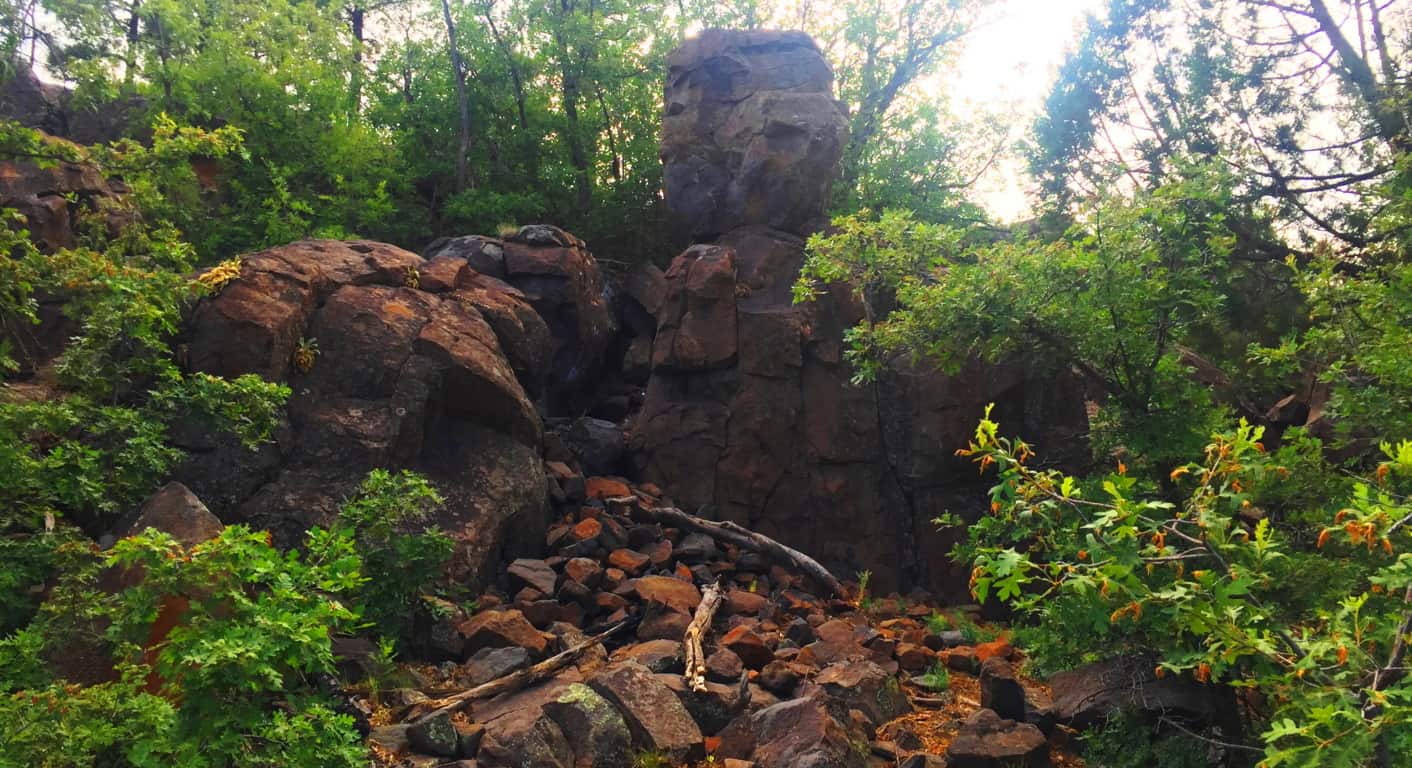
The image above is another look at the small cliff-face with a distinctly placed free-sitting boulder, etched just below the top of the broad hill beyond. I can’t stress it enough, how similar this is to places in New England, where magical things often loom in deep gully’s, which unless you stop and dip down into them, you would simply pass by, gaining no knowledge of the concealed area at all. Here’s another look at the surprising frequency of boulders beneath the trees in this wonderful place. (Image/Below) 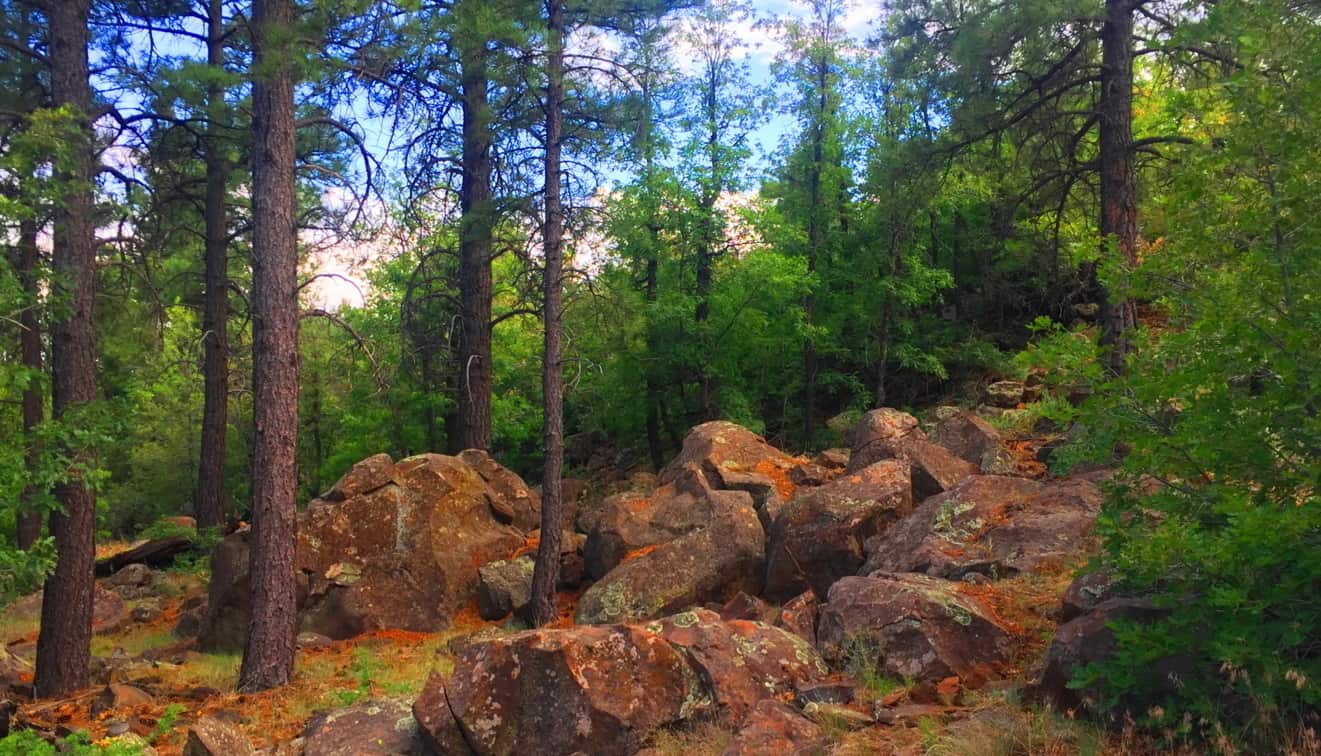
Once you are ready to step into the larger Coconino Forest at the base of Mount Humphries, you can simply drive up to one of the many Trailheads. I used the entrance at Trinity Methodist Church, sitting on the literal edge of the vast woods.  There are dozens of trails winding through this spacious and beautiful set of glades, with massive stones set in incredible positions that give serious pause. This amazing stone was there to greet me as soon as I walked in. (Image/Below) You just can’t make this stuff up.
There are dozens of trails winding through this spacious and beautiful set of glades, with massive stones set in incredible positions that give serious pause. This amazing stone was there to greet me as soon as I walked in. (Image/Below) You just can’t make this stuff up.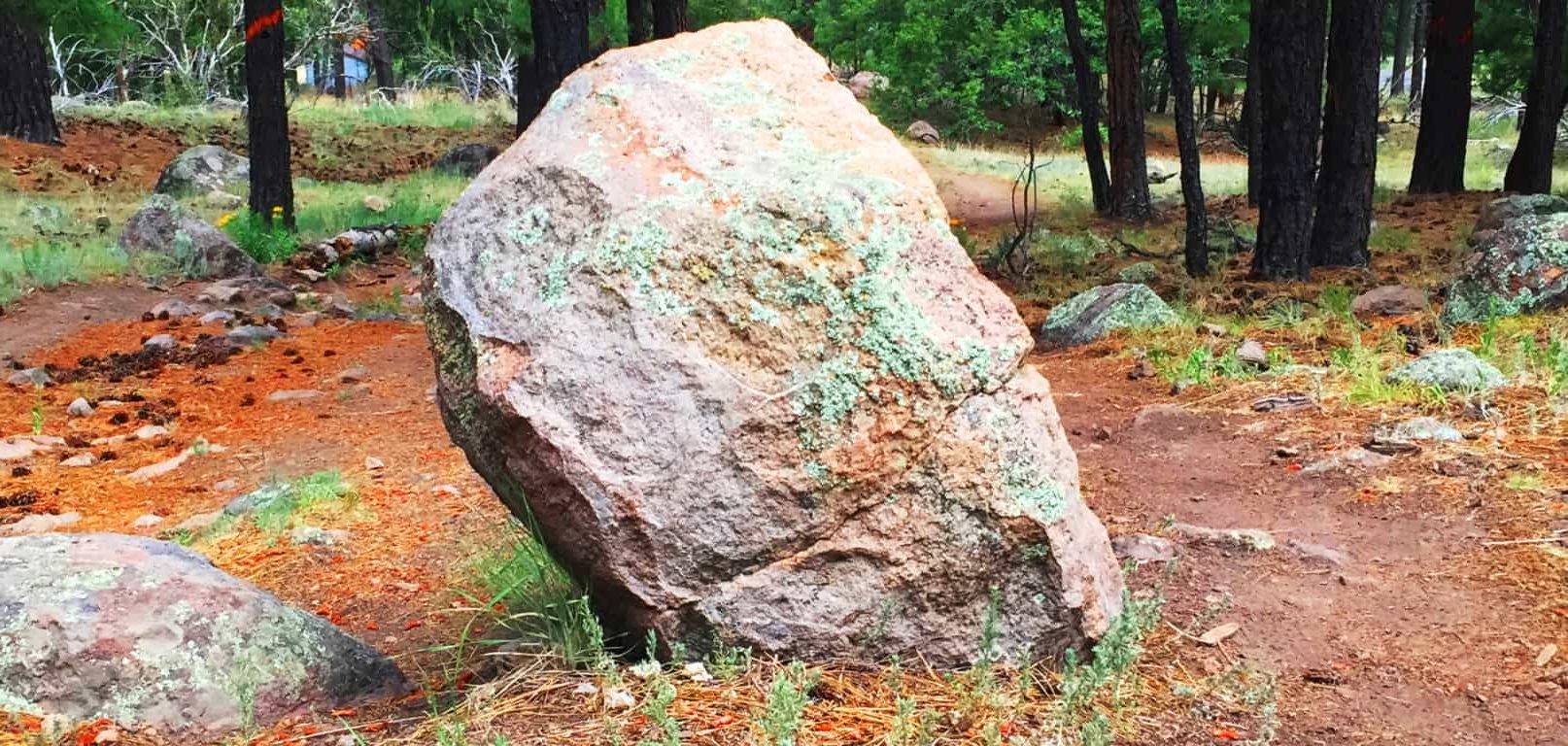
This stone is essentially standing straight up at about 4 feet high, with only a five inch width, which is relatively thin. It is also buried deep within the ground, and make no mistake, this a massive rock. There is a type of streak across the center, with an oblong leaning of the overall shape. I was excited to see a type of “statement stone” as soon as I began my hike. The forest felt strange, mysterious and beautiful. Stones like these in New England are very similar, but this seemed a different style all together! As I progressed further towards the base of the mountain, another stone, more convincing as a Standing Stone, emerged. (image/Below)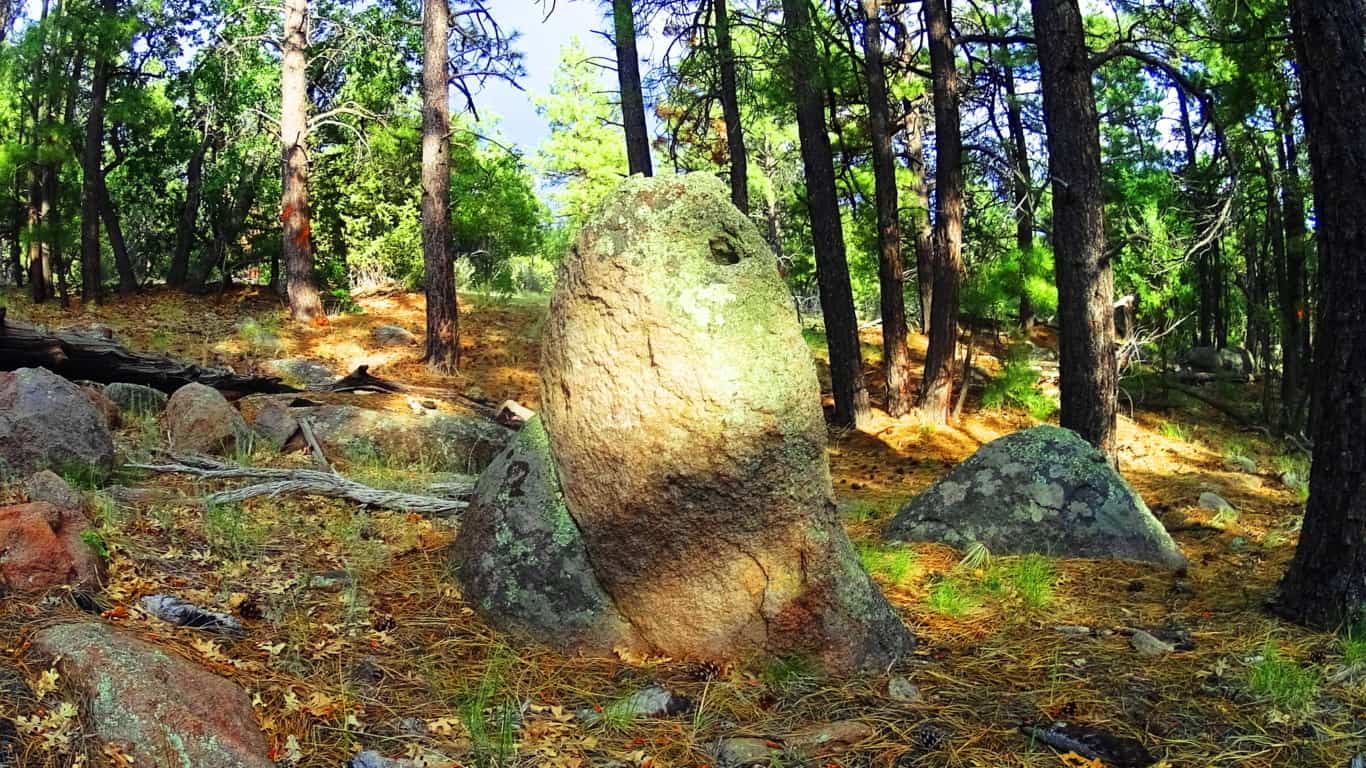
Here is another huge stone standing straight up at about 5 feet tall, and about three inches in width. At this point I was having that moment, just like I’ve had at Cavan Burren National Park in Ireland, and Monument Mountain in Massachusetts, when I said to myself: “O.k, what in God’s name is going on in this enchanted place?” And that feeling of ‘Lothlorien’ begins to sink in, all over again…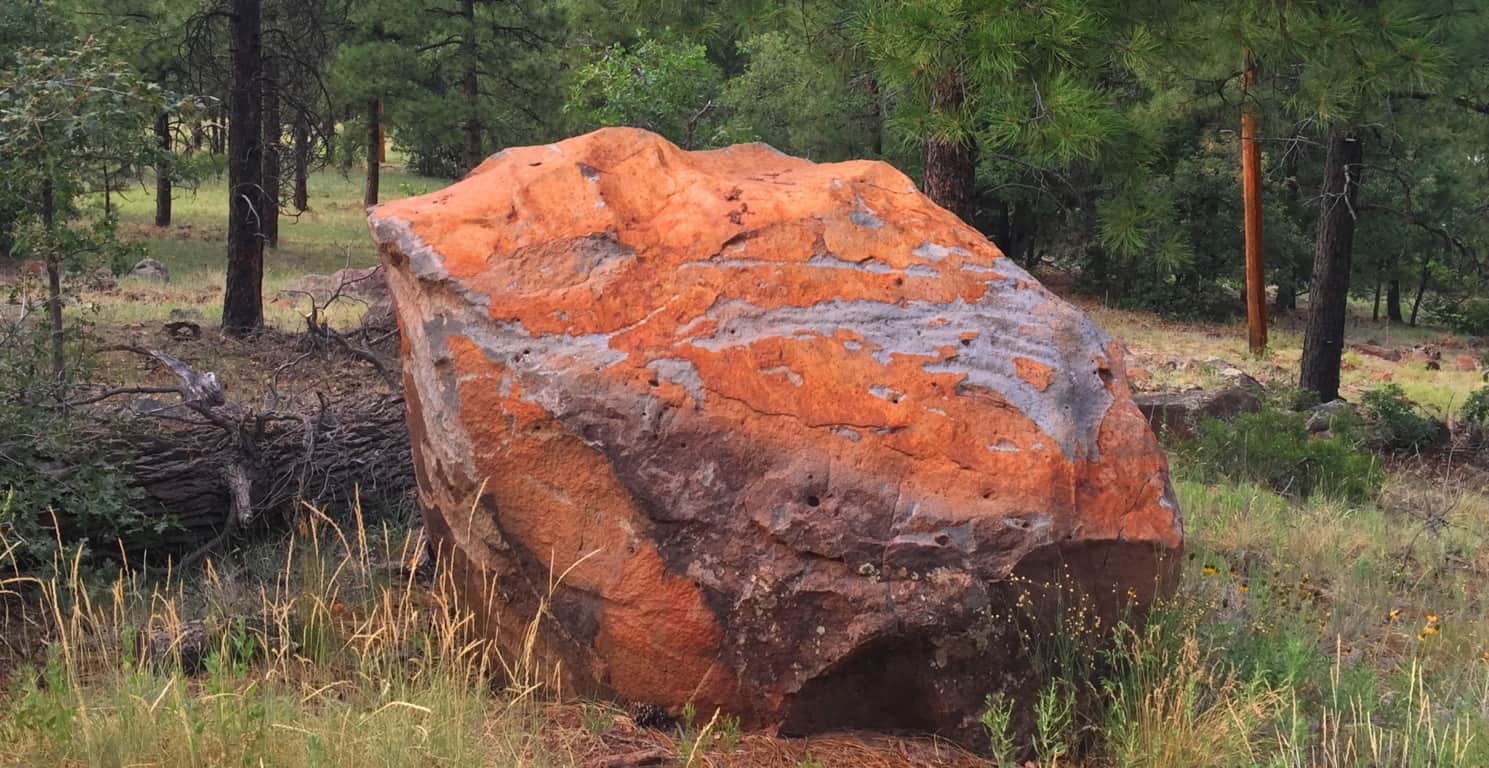
Take a look at this boulder above, which was on the edge of the woods. It was so isolated and stoic, extremely similar to the boulder at Cavan Burren National Park I described above. I could not help but feel that this was another territorial marker, just like at Celtic sites. I even pictured it painted with various markings to increase its distinction, as they are depicted in the mythical xbox game Skyrim, protected by giants living their primordial existence.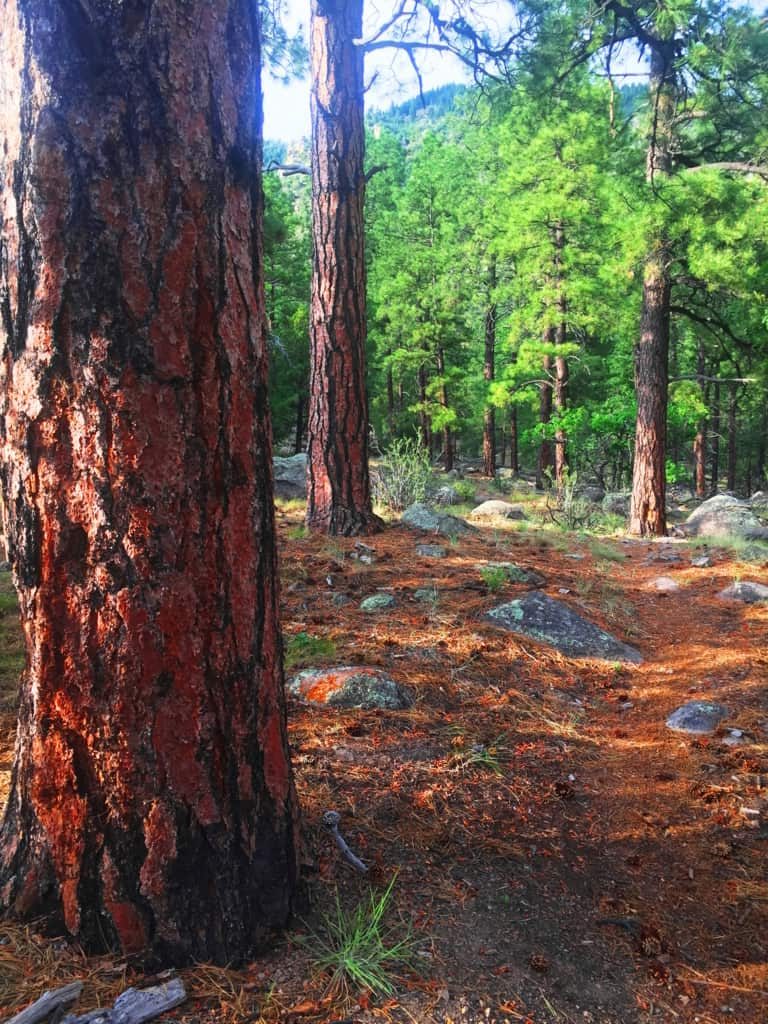 Hundreds of distinct statements like this can be found in the Flagstaff Coconino. Something spectacular is going in this place, so spectacular, that its hard to totally understand. Aside from the threat of fire in July, the place was incredibly peaceful. Against Mount Humphries, the forest seemed ultimately protected from the North, tucked-in enough for the natives to build there homes here, which of-course they did. The trees are spaciously placed with a rusty orange glow along the tough exteriors and the forest floor, very much like New England Pine glades. The air is so dry that you can taste the hovering heat in the pocket of your tongue, like the taste of charcoal in the wind at a barbecue. Any spot is a great spot to sit down, take a nap, take a picture or video, and just fall into the peace and quiet of this massive natural space. It is pure medicine for your mind, against a modern world constantly driving us into the lower aspects of existence, which is the material and monetary contest we experience to survive. The Coconino’ makes you forget, in the best possible way; through the wind in the trees.
Hundreds of distinct statements like this can be found in the Flagstaff Coconino. Something spectacular is going in this place, so spectacular, that its hard to totally understand. Aside from the threat of fire in July, the place was incredibly peaceful. Against Mount Humphries, the forest seemed ultimately protected from the North, tucked-in enough for the natives to build there homes here, which of-course they did. The trees are spaciously placed with a rusty orange glow along the tough exteriors and the forest floor, very much like New England Pine glades. The air is so dry that you can taste the hovering heat in the pocket of your tongue, like the taste of charcoal in the wind at a barbecue. Any spot is a great spot to sit down, take a nap, take a picture or video, and just fall into the peace and quiet of this massive natural space. It is pure medicine for your mind, against a modern world constantly driving us into the lower aspects of existence, which is the material and monetary contest we experience to survive. The Coconino’ makes you forget, in the best possible way; through the wind in the trees. 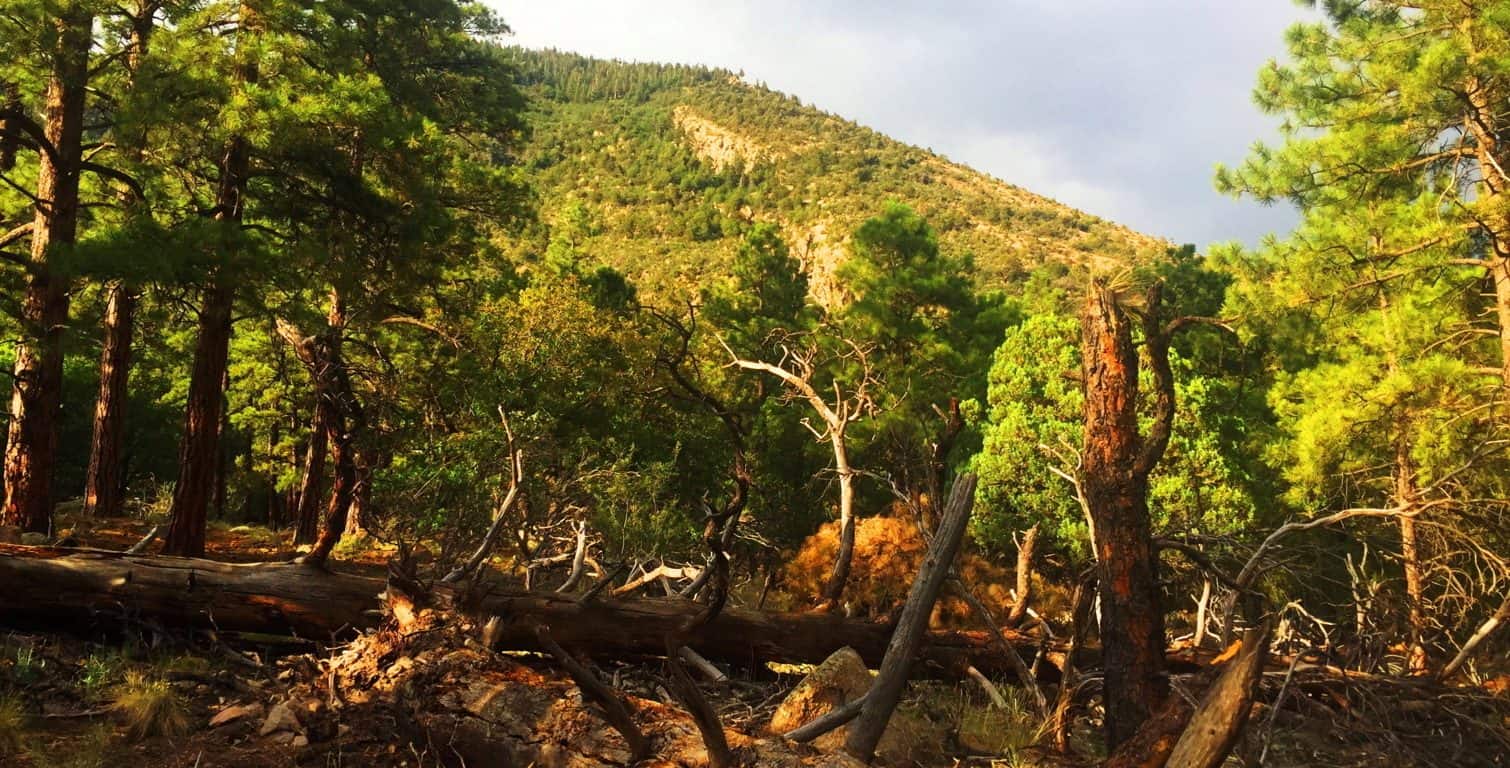
Coconino Forest at Oak Creek Canyon/Sedona: After walking out of the Forest at Flagstaff, I had real and tangible reasons to believe that the Neolithic Culture inhabited this place, just like the myths of the Natives speak of. The following day, heading down to the southern extreme of the Coconino’ from Flagstaff, to Oak Creek Canyon, there are two southerly highways. Take the 89A, not Route 17. The 89A is one of the most beautiful back-highways in the country, and scenic Coconino forestry all the way down into the Canyon. The distance from Flagstaff to Oak Creek is only about an hour, the entire trip a wonderful experience. Bring cameras and water, and be ready to freak-out on the beautiful southern extension of the Coconino!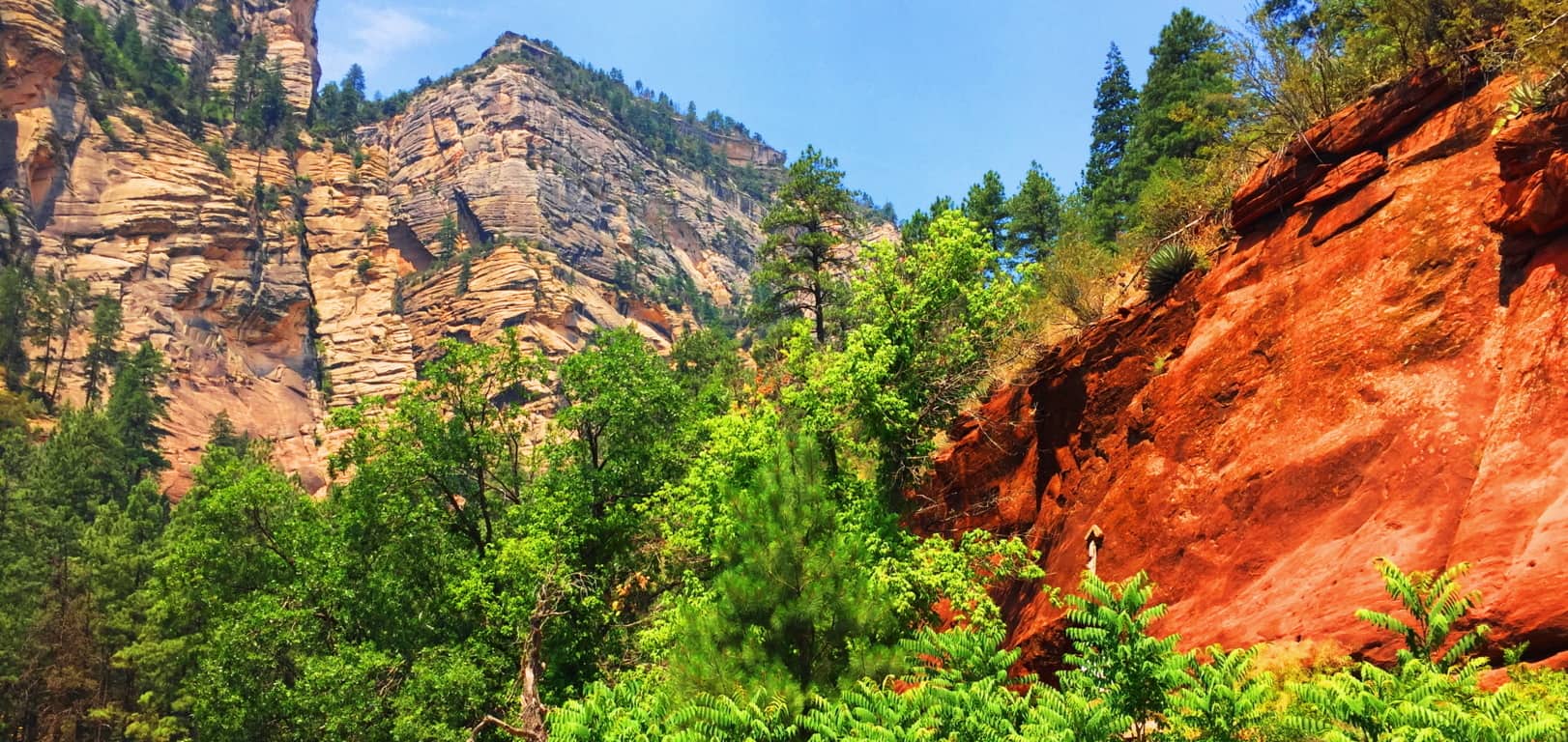
Oak Creek is its own excursion, with magical stones, free-sitting boulders, and habitations well worth several treks. (See “Oak Creek Canyon” at Stonestrider.com for the complete experience.) The most important thing to understand is that the Coconino forest reaches all the way to this southern tip of the central portion of Arizona. This forest is massive and gorgeous, and as mysterious as any Celtic place I’ve ever seen. The trails here are cool and distinct, marked by lonely boulders that seem to be markers, yet again. The Forest grows thickly, with perhaps the tallest of Ponderosa Pines in all Arizona, featured in the very top image of this article. The Coconino Forest is enchanted with a rare Trinity of locations; found in Canyon, Mountain, and Desert. 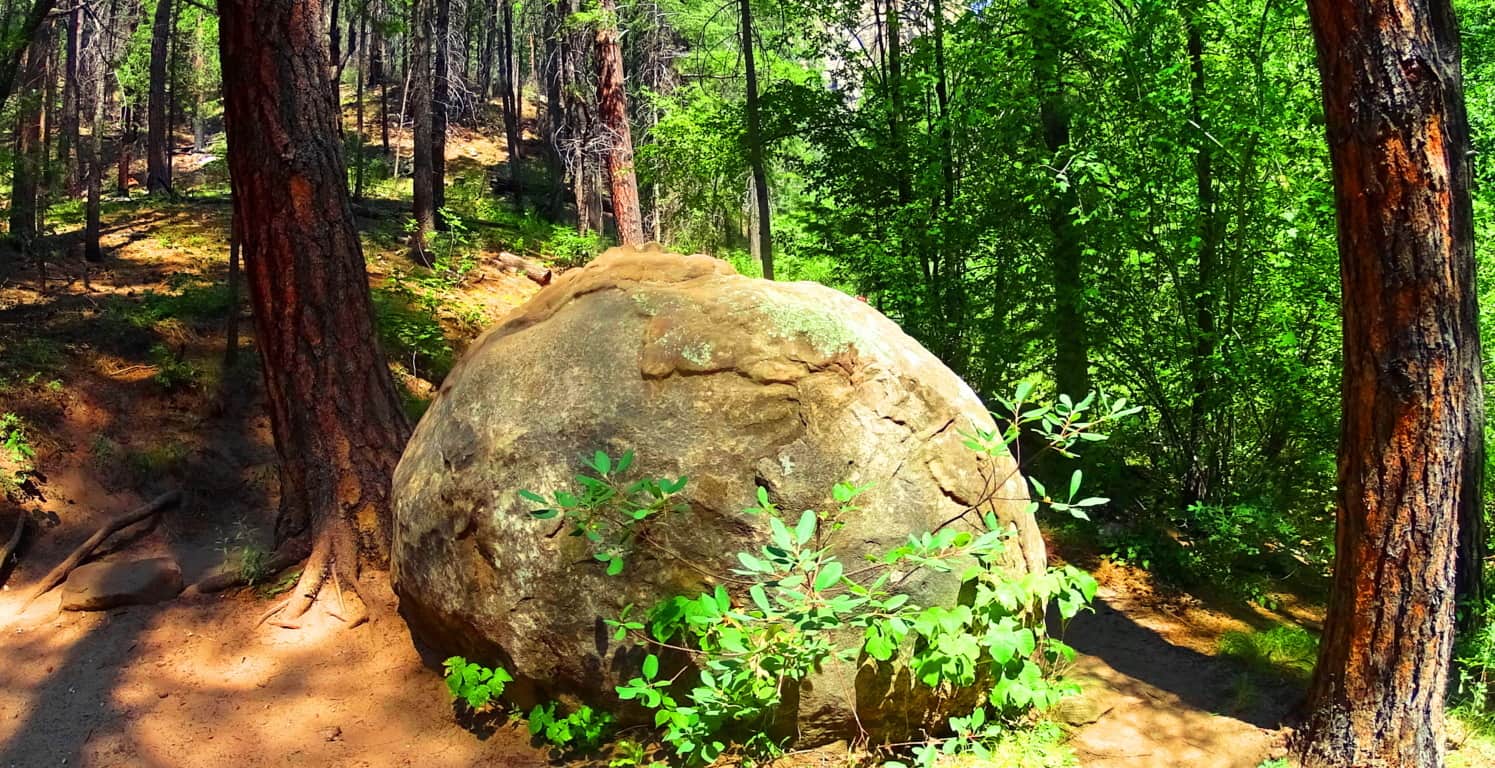
The Coconino Forest of Arizona is another dreamscape with mysterious statements strewn throughout the gigantic woods. It is the majestic wood-belt of Arizona, and in terms of scale, trumping Celtic forests in every possible way. Did the same Neolithic Culture which I believe existed in the forests of Celtic places exist here? I believe they did. Let yourself wander beneath these Pondersa Pines. There are mountains, volcanos, canyons, deserts, and grassy plateaus, where you find this Forest’s trails. It is an all-embracing Forest that pushes through the most arid of environments to ultimately give life and shade to this part of the world. The most important message I can convey at the end of this article is that reading about a forest is all well and good, but entering into one is the overall goal. You can get there and experience this massive life-force for yourself; it’s not a cliche. Seek it out, and find it out. Use your own mind to experience places like this, and don’t let the information-comptrollers and false-history writers deny you your allotted connection and interaction with this amazing primordial source of life in our world. Look and decide for yourself what happened in this gorgeous place. Go strong. Stonestrider.com.